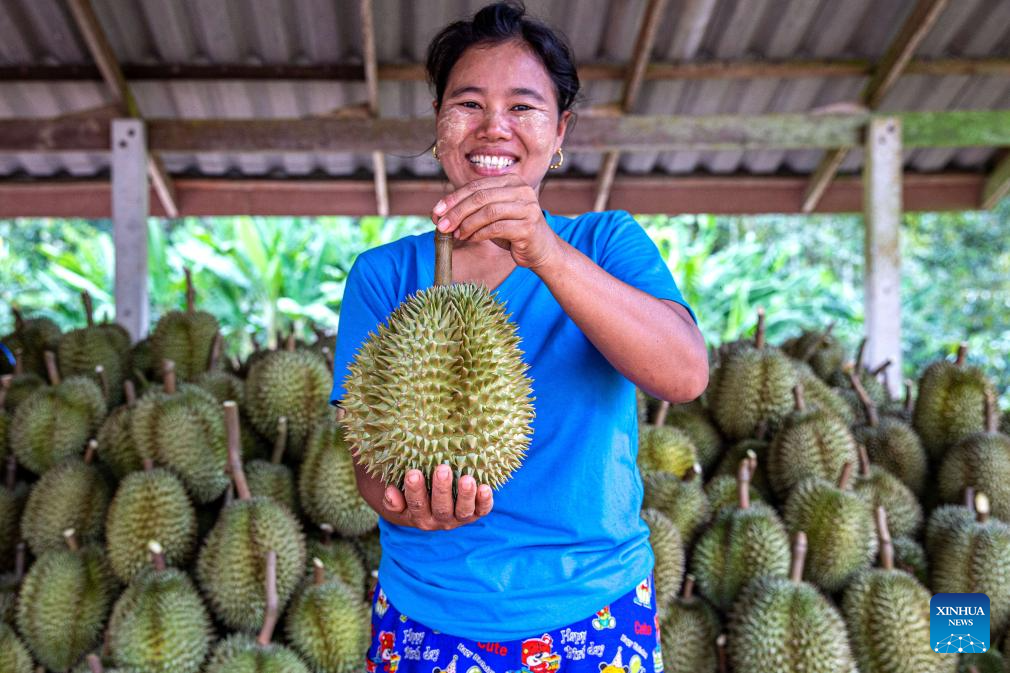
A worker displays a freshly harvested durian at an orchard in Chumphon, Thailand, Sept. 18, 2023. According to data from Thailand's Ministry of Commerce, China was the largest export market for Thai durians in 2022, accounting for more than 96 percent of the total export volume. As the vast majority of durians sold in the Chinese market are imported from Southeast Asia, the "king of fruits" has emerged as a prominent symbol of the booming China-ASEAN cooperation and China's vast market potential.
The flow of goods in this regional market has continued to benefit from tariff-free policies and expanded market access under the frameworks of the China-ASEAN Free Trade Area and the Regional Comprehensive Economic Partnership (RCEP).
In the first five months of this year, Guangxi imported 3.66 billion yuan worth of fruits from ASEAN countries, a marked rise of 194 percent year on year. Among the most notable increases is durian, which surged 516 percent from the same period last year, according to customs data. (Xinhua/Wang Teng)
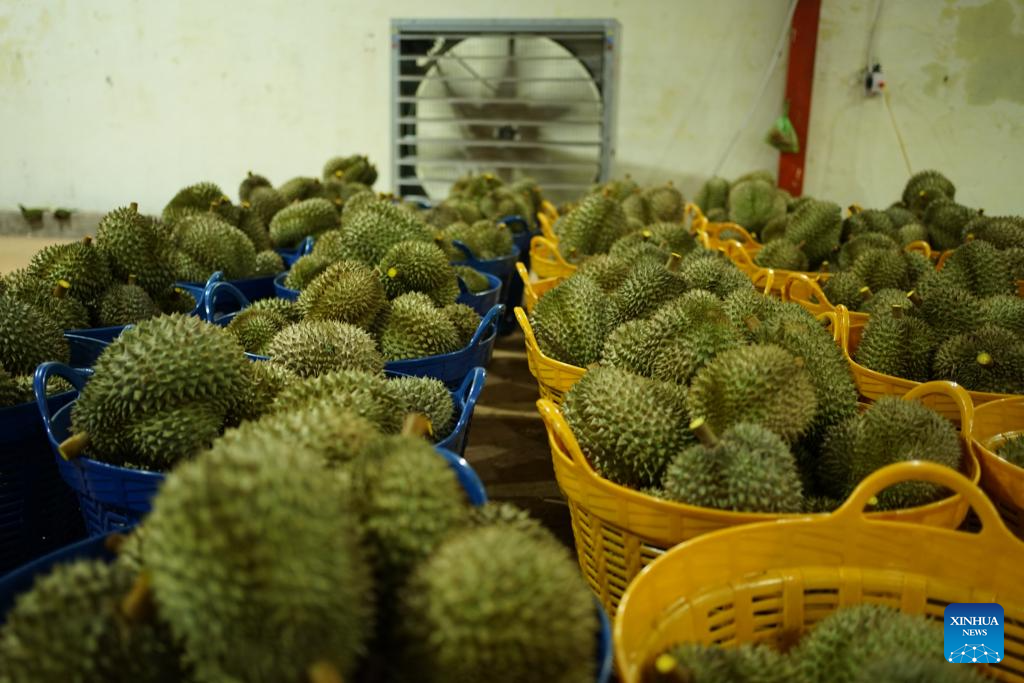
This photo taken on Sept. 15, 2023 shows some fresh durians that have been preprocessed at a durian processing plant in Dak Lak province, Vietnam. Dak Lak is a leading durian-growing province in the country. As the vast majority of durians sold in the Chinese market are imported from Southeast Asia, the "king of fruits" has emerged as a prominent symbol of the booming China-ASEAN cooperation and China's vast market potential.
The flow of goods in this regional market has continued to benefit from tariff-free policies and expanded market access under the frameworks of the China-ASEAN Free Trade Area and the Regional Comprehensive Economic Partnership (RCEP).
In the first five months of this year, Guangxi imported 3.66 billion yuan worth of fruits from ASEAN countries, a marked rise of 194 percent year on year. Among the most notable increases is durian, which surged 516 percent from the same period last year, according to customs data. (Xinhua/Hu Jiali)
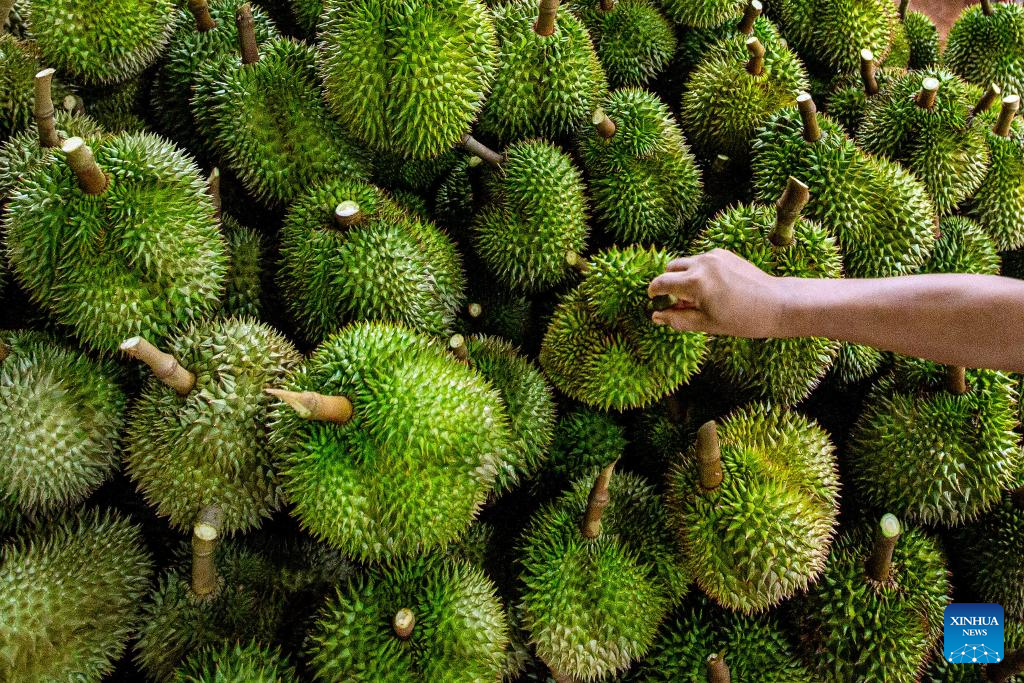
A worker piles freshly harvested durians at an orchard in Chumphon, Thailand, Sept. 18, 2023. According to data from Thailand's Ministry of Commerce, China was the largest export market for Thai durians in 2022, accounting for more than 96 percent of the total export volume. As the vast majority of durians sold in the Chinese market are imported from Southeast Asia, the "king of fruits" has emerged as a prominent symbol of the booming China-ASEAN cooperation and China's vast market potential.
The flow of goods in this regional market has continued to benefit from tariff-free policies and expanded market access under the frameworks of the China-ASEAN Free Trade Area and the Regional Comprehensive Economic Partnership (RCEP).
In the first five months of this year, Guangxi imported 3.66 billion yuan worth of fruits from ASEAN countries, a marked rise of 194 percent year on year. Among the most notable increases is durian, which surged 516 percent from the same period last year, according to customs data. (Xinhua/Wang Teng)
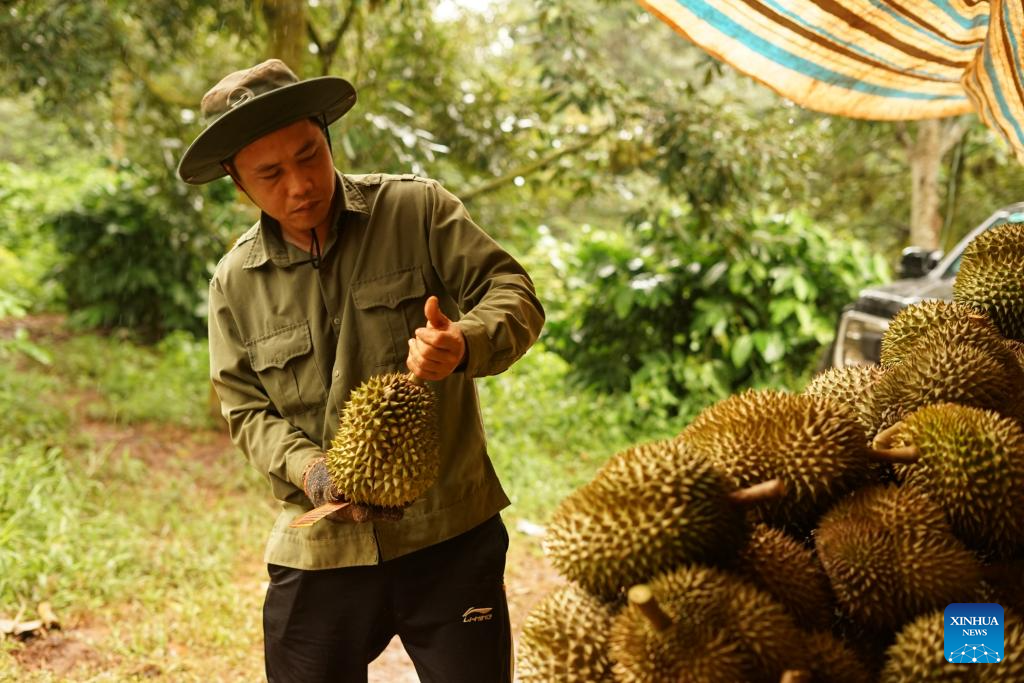
A farmer conducts preliminary cleaning for freshly harvested durians at a durian orchard in Dak Lak province, Vietnam, on Sept. 15, 2023. Dak Lak is a leading durian-growing province in the country. As the vast majority of durians sold in the Chinese market are imported from Southeast Asia, the "king of fruits" has emerged as a prominent symbol of the booming China-ASEAN cooperation and China's vast market potential.
The flow of goods in this regional market has continued to benefit from tariff-free policies and expanded market access under the frameworks of the China-ASEAN Free Trade Area and the Regional Comprehensive Economic Partnership (RCEP).
In the first five months of this year, Guangxi imported 3.66 billion yuan worth of fruits from ASEAN countries, a marked rise of 194 percent year on year. Among the most notable increases is durian, which surged 516 percent from the same period last year, according to customs data. (Xinhua/Hu Jiali)
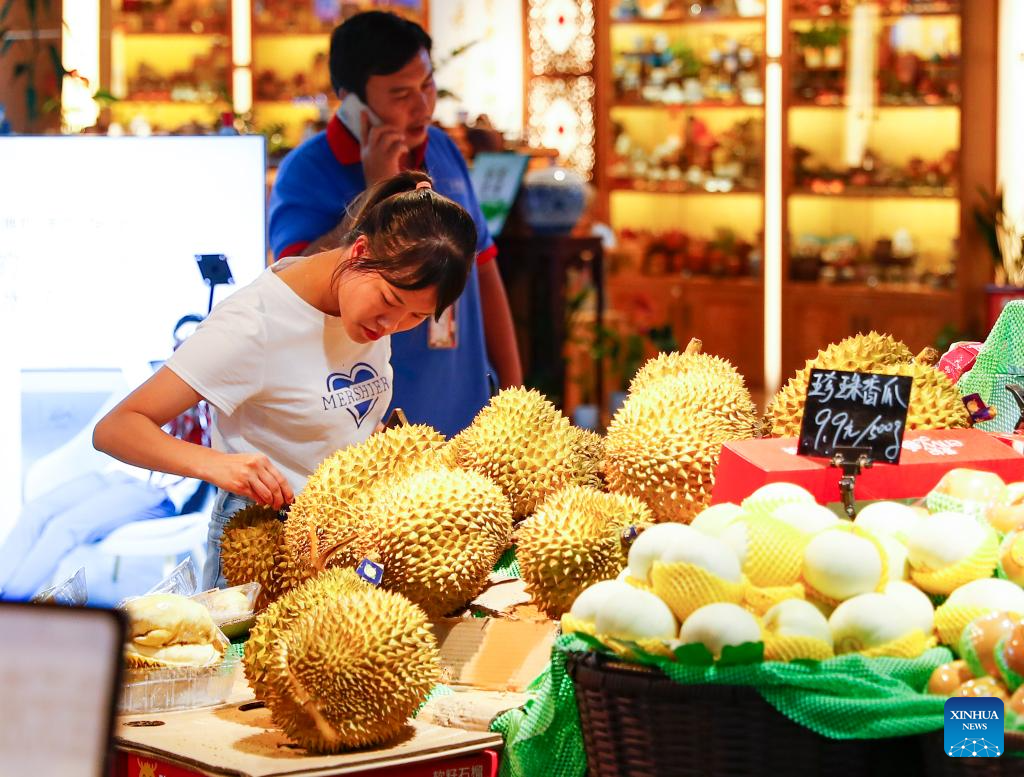
A woman chooses durians imported from Thailand at a supermarket in Nanning, south China's Guangxi Zhuang Autonomous Region, Sept. 7, 2023. As the vast majority of durians sold in the Chinese market are imported from Southeast Asia, the "king of fruits" has emerged as a prominent symbol of the booming China-ASEAN cooperation and China's vast market potential.
The flow of goods in this regional market has continued to benefit from tariff-free policies and expanded market access under the frameworks of the China-ASEAN Free Trade Area and the Regional Comprehensive Economic Partnership (RCEP).
In the first five months of this year, Guangxi imported 3.66 billion yuan worth of fruits from ASEAN countries, a marked rise of 194 percent year on year. Among the most notable increases is durian, which surged 516 percent from the same period last year, according to customs data. (Xinhua/Hu Xingyu)

A staff member packs durians at a durian processing plant in Dak Lak province, Vietnam, on Sept. 15, 2023. Dak Lak is a leading durian-growing province in the country. As the vast majority of durians sold in the Chinese market are imported from Southeast Asia, the "king of fruits" has emerged as a prominent symbol of the booming China-ASEAN cooperation and China's vast market potential.
The flow of goods in this regional market has continued to benefit from tariff-free policies and expanded market access under the frameworks of the China-ASEAN Free Trade Area and the Regional Comprehensive Economic Partnership (RCEP).
In the first five months of this year, Guangxi imported 3.66 billion yuan worth of fruits from ASEAN countries, a marked rise of 194 percent year on year. Among the most notable increases is durian, which surged 516 percent from the same period last year, according to customs data. (Photo by Pham Dinh Duc/Xinhua)
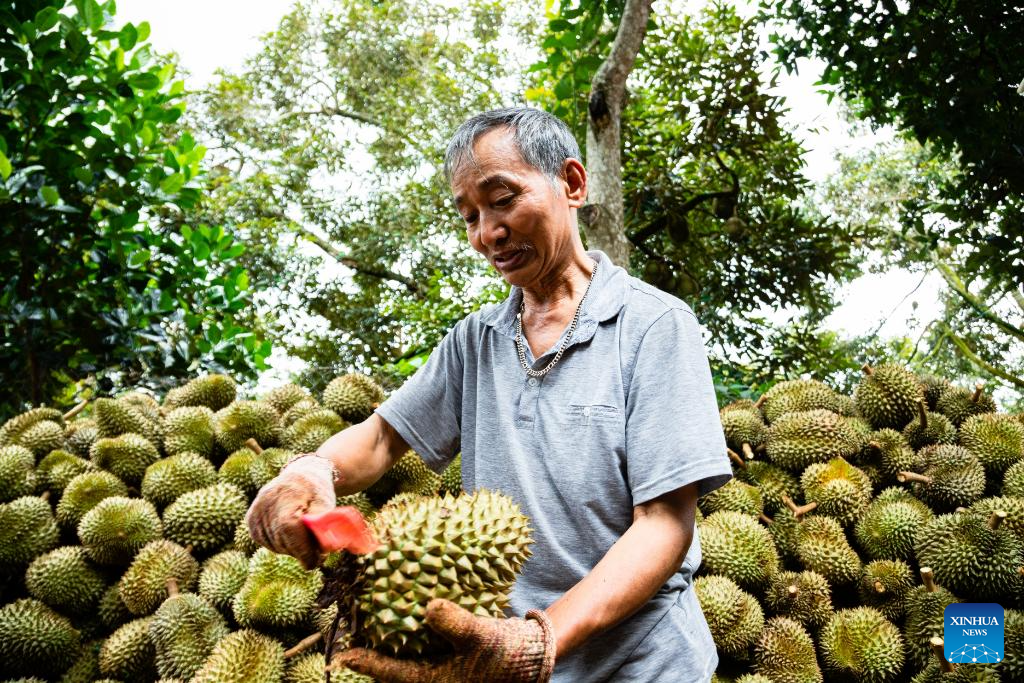
A farmer conducts preliminary cleaning for freshly harvested durians at a durian orchard in Dak Lak province, Vietnam, on Sept. 15, 2023. Dak Lak is a leading durian-growing province in the country. As the vast majority of durians sold in the Chinese market are imported from Southeast Asia, the "king of fruits" has emerged as a prominent symbol of the booming China-ASEAN cooperation and China's vast market potential.
The flow of goods in this regional market has continued to benefit from tariff-free policies and expanded market access under the frameworks of the China-ASEAN Free Trade Area and the Regional Comprehensive Economic Partnership (RCEP).
In the first five months of this year, Guangxi imported 3.66 billion yuan worth of fruits from ASEAN countries, a marked rise of 194 percent year on year. Among the most notable increases is durian, which surged 516 percent from the same period last year, according to customs data. (Photo by Pham Dinh Duc/Xinhua)
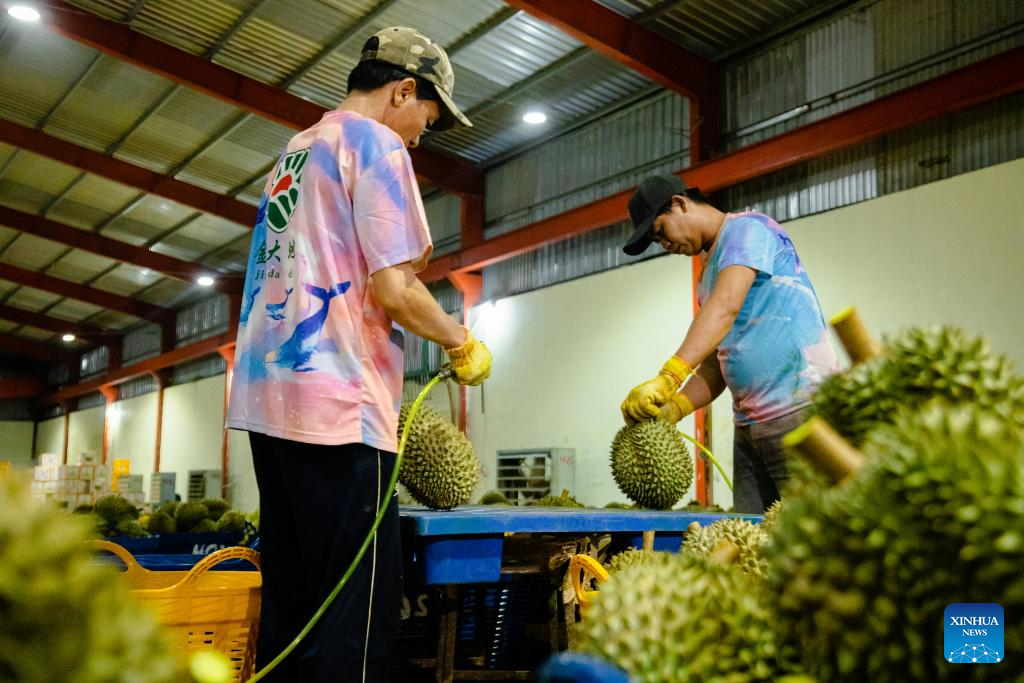
Staff members clean fresh durians at a durian processing plant in Dak Lak province, Vietnam, on Sept. 15, 2023. Dak Lak is a leading durian-growing province in the country. As the vast majority of durians sold in the Chinese market are imported from Southeast Asia, the "king of fruits" has emerged as a prominent symbol of the booming China-ASEAN cooperation and China's vast market potential.
The flow of goods in this regional market has continued to benefit from tariff-free policies and expanded market access under the frameworks of the China-ASEAN Free Trade Area and the Regional Comprehensive Economic Partnership (RCEP).
In the first five months of this year, Guangxi imported 3.66 billion yuan worth of fruits from ASEAN countries, a marked rise of 194 percent year on year. Among the most notable increases is durian, which surged 516 percent from the same period last year, according to customs data. (Photo by Pham Dinh Duc/Xinhua)
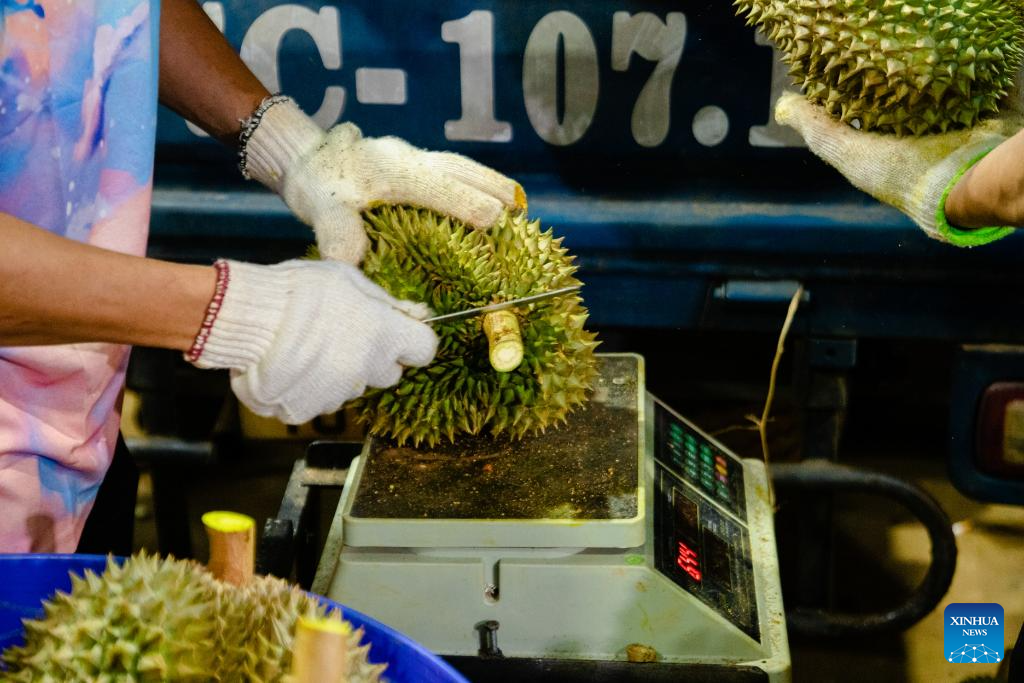
Staff members process fresh durians at a durian processing plant in Dak Lak province, Vietnam, on Sept. 15, 2023. Dak Lak is a leading durian-growing province in the country. As the vast majority of durians sold in the Chinese market are imported from Southeast Asia, the "king of fruits" has emerged as a prominent symbol of the booming China-ASEAN cooperation and China's vast market potential.
The flow of goods in this regional market has continued to benefit from tariff-free policies and expanded market access under the frameworks of the China-ASEAN Free Trade Area and the Regional Comprehensive Economic Partnership (RCEP).
In the first five months of this year, Guangxi imported 3.66 billion yuan worth of fruits from ASEAN countries, a marked rise of 194 percent year on year. Among the most notable increases is durian, which surged 516 percent from the same period last year, according to customs data. (Photo by Pham Dinh Duc/Xinhua)

Staff members unload and sort out durians at a durian processing plant in Dak Lak province, Vietnam, on Sept. 15, 2023. Dak Lak is a leading durian-growing province in the country. As the vast majority of durians sold in the Chinese market are imported from Southeast Asia, the "king of fruits" has emerged as a prominent symbol of the booming China-ASEAN cooperation and China's vast market potential.
The flow of goods in this regional market has continued to benefit from tariff-free policies and expanded market access under the frameworks of the China-ASEAN Free Trade Area and the Regional Comprehensive Economic Partnership (RCEP).
In the first five months of this year, Guangxi imported 3.66 billion yuan worth of fruits from ASEAN countries, a marked rise of 194 percent year on year. Among the most notable increases is durian, which surged 516 percent from the same period last year, according to customs data. (Photo by Pham Dinh Duc/Xinhua)
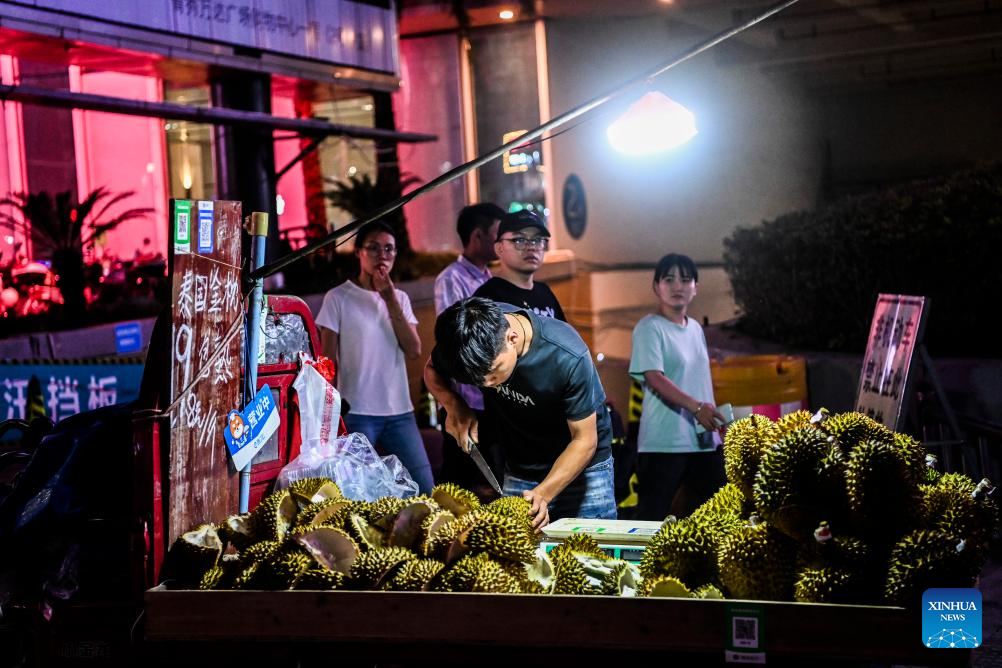
A vendor sells durians imported from Thailand on a street in Nanning, south China's Guangxi Zhuang Autonomous Region, on Sept. 17, 2023. As the vast majority of durians sold in the Chinese market are imported from Southeast Asia, the "king of fruits" has emerged as a prominent symbol of the booming China-ASEAN cooperation and China's vast market potential.
The flow of goods in this regional market has continued to benefit from tariff-free policies and expanded market access under the frameworks of the China-ASEAN Free Trade Area and the Regional Comprehensive Economic Partnership (RCEP).
In the first five months of this year, Guangxi imported 3.66 billion yuan worth of fruits from ASEAN countries, a marked rise of 194 percent year on year. Among the most notable increases is durian, which surged 516 percent from the same period last year, according to customs data. (Xinhua/Hu Xingyu)
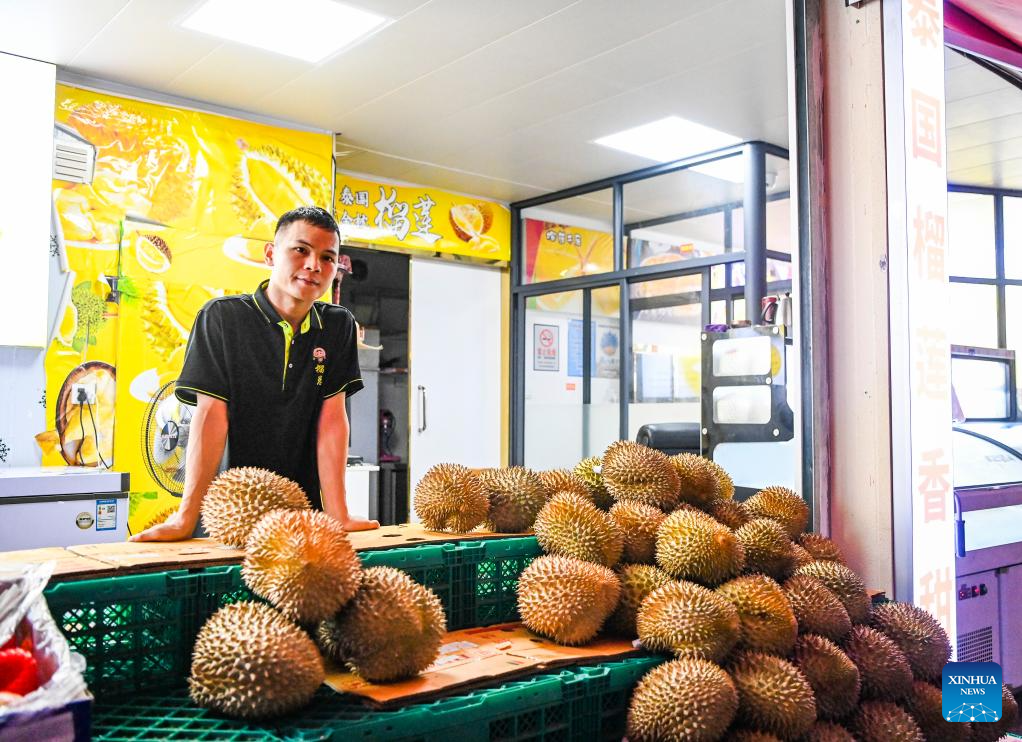
A vendor sells durians imported from Thailand on a street in Nanning, south China's Guangxi Zhuang Autonomous Region, on Sept. 17, 2023. As the vast majority of durians sold in the Chinese market are imported from Southeast Asia, the "king of fruits" has emerged as a prominent symbol of the booming China-ASEAN cooperation and China's vast market potential.
The flow of goods in this regional market has continued to benefit from tariff-free policies and expanded market access under the frameworks of the China-ASEAN Free Trade Area and the Regional Comprehensive Economic Partnership (RCEP).
In the first five months of this year, Guangxi imported 3.66 billion yuan worth of fruits from ASEAN countries, a marked rise of 194 percent year on year. Among the most notable increases is durian, which surged 516 percent from the same period last year, according to customs data. (Xinhua/Hu Xingyu)

Durian-flavored desserts are pictured at a snack shop in Nanning, south China's Guangxi Zhuang Autonomous Region, on Sept. 17, 2023. As the vast majority of durians sold in the Chinese market are imported from Southeast Asia, the "king of fruits" has emerged as a prominent symbol of the booming China-ASEAN cooperation and China's vast market potential.
The flow of goods in this regional market has continued to benefit from tariff-free policies and expanded market access under the frameworks of the China-ASEAN Free Trade Area and the Regional Comprehensive Economic Partnership (RCEP).
In the first five months of this year, Guangxi imported 3.66 billion yuan worth of fruits from ASEAN countries, a marked rise of 194 percent year on year. Among the most notable increases is durian, which surged 516 percent from the same period last year, according to customs data. (Xinhua/Hu Xingyu)
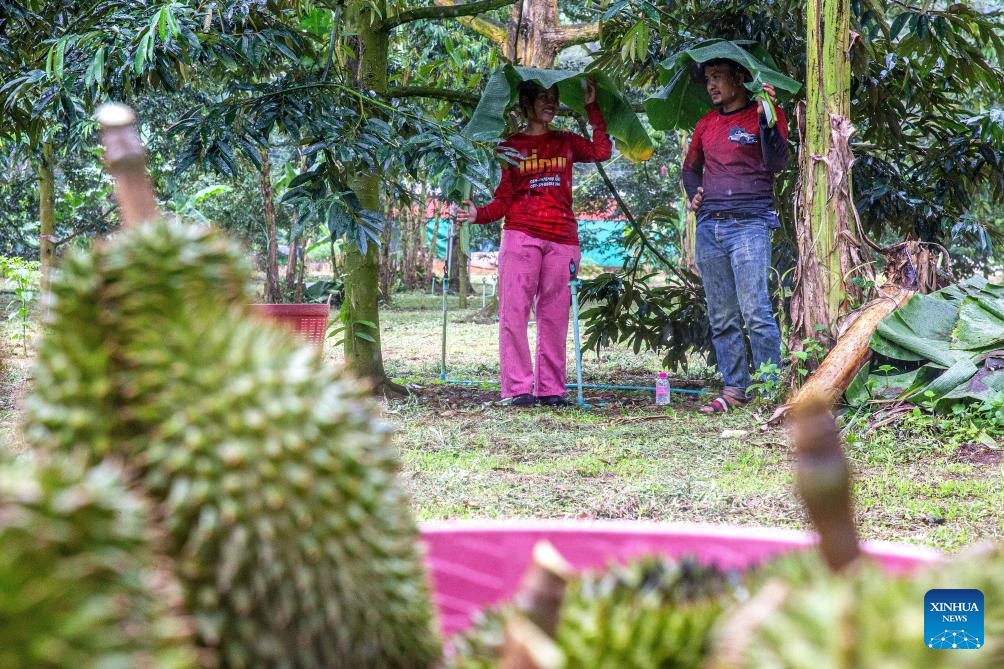
Workers take shelter from the rain at an orchard in Chumphon, Thailand, Sept. 18, 2023. According to data from Thailand's Ministry of Commerce, China was the largest export market for Thai durians in 2022, accounting for more than 96 percent of the total export volume. As the vast majority of durians sold in the Chinese market are imported from Southeast Asia, the "king of fruits" has emerged as a prominent symbol of the booming China-ASEAN cooperation and China's vast market potential.
The flow of goods in this regional market has continued to benefit from tariff-free policies and expanded market access under the frameworks of the China-ASEAN Free Trade Area and the Regional Comprehensive Economic Partnership (RCEP).
In the first five months of this year, Guangxi imported 3.66 billion yuan worth of fruits from ASEAN countries, a marked rise of 194 percent year on year. Among the most notable increases is durian, which surged 516 percent from the same period last year, according to customs data. (Xinhua/Wang Teng)
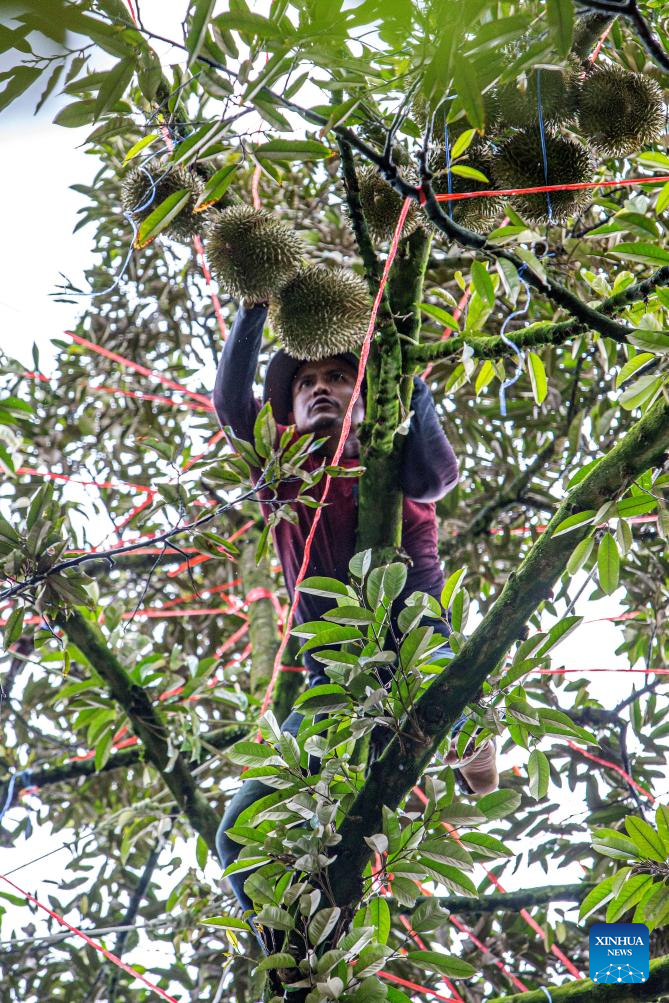
A worker cuts durians off from a tree at an orchard in Chumphon, Thailand, Sept. 18, 2023. According to data from Thailand's Ministry of Commerce, China was the largest export market for Thai durians in 2022, accounting for more than 96 percent of the total export volume. As the vast majority of durians sold in the Chinese market are imported from Southeast Asia, the "king of fruits" has emerged as a prominent symbol of the booming China-ASEAN cooperation and China's vast market potential.
The flow of goods in this regional market has continued to benefit from tariff-free policies and expanded market access under the frameworks of the China-ASEAN Free Trade Area and the Regional Comprehensive Economic Partnership (RCEP).
In the first five months of this year, Guangxi imported 3.66 billion yuan worth of fruits from ASEAN countries, a marked rise of 194 percent year on year. Among the most notable increases is durian, which surged 516 percent from the same period last year, according to customs data. (Xinhua/Wang Teng)
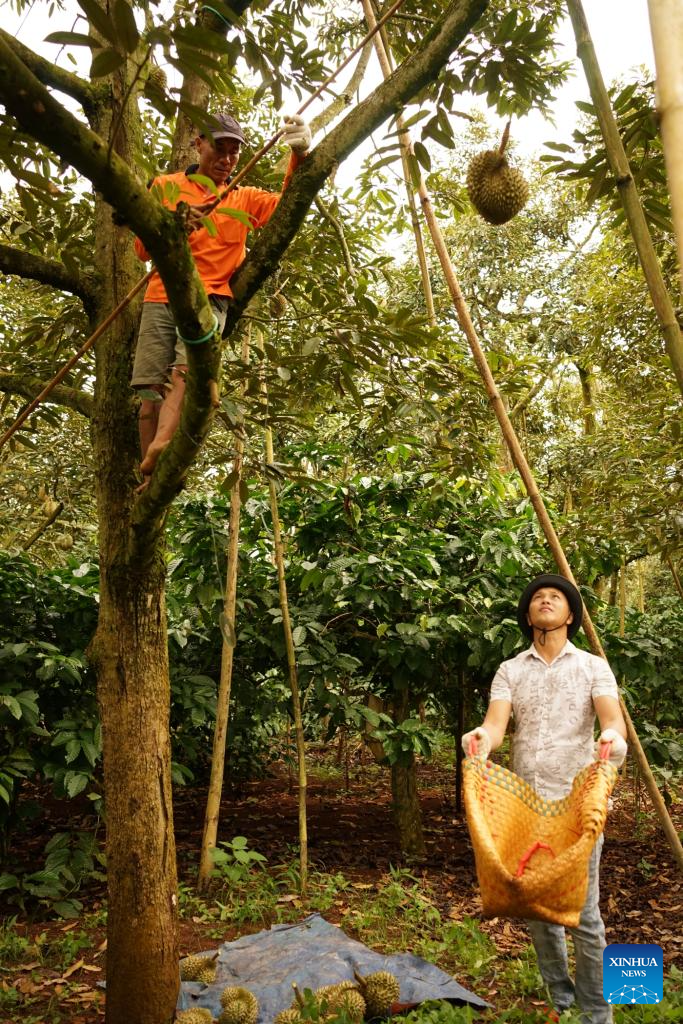
Staff members harvest durians at a durian orchard in Dak Lak province, Vietnam, on Sept. 15, 2023. Dak Lak is a leading durian-growing province in the country. As the vast majority of durians sold in the Chinese market are imported from Southeast Asia, the "king of fruits" has emerged as a prominent symbol of the booming China-ASEAN cooperation and China's vast market potential.
The flow of goods in this regional market has continued to benefit from tariff-free policies and expanded market access under the frameworks of the China-ASEAN Free Trade Area and the Regional Comprehensive Economic Partnership (RCEP).
In the first five months of this year, Guangxi imported 3.66 billion yuan worth of fruits from ASEAN countries, a marked rise of 194 percent year on year. Among the most notable increases is durian, which surged 516 percent from the same period last year, according to customs data. (Xinhua/Hu Jiali)
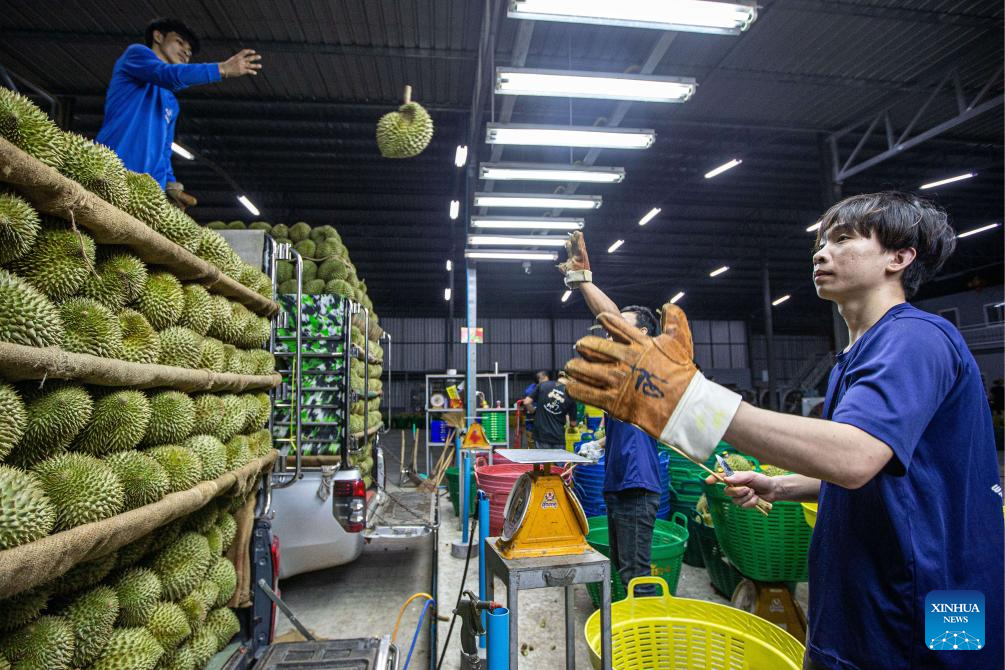
Staff members sort freshly harvested durians at a durian plant in Chumphon, Thailand, Sept. 18, 2023. According to data from Thailand's Ministry of Commerce, China was the largest export market for Thai durians in 2022, accounting for more than 96 percent of the total export volume. As the vast majority of durians sold in the Chinese market are imported from Southeast Asia, the "king of fruits" has emerged as a prominent symbol of the booming China-ASEAN cooperation and China's vast market potential.
The flow of goods in this regional market has continued to benefit from tariff-free policies and expanded market access under the frameworks of the China-ASEAN Free Trade Area and the Regional Comprehensive Economic Partnership (RCEP).
In the first five months of this year, Guangxi imported 3.66 billion yuan worth of fruits from ASEAN countries, a marked rise of 194 percent year on year. Among the most notable increases is durian, which surged 516 percent from the same period last year, according to customs data. (Xinhua/Wang Teng)
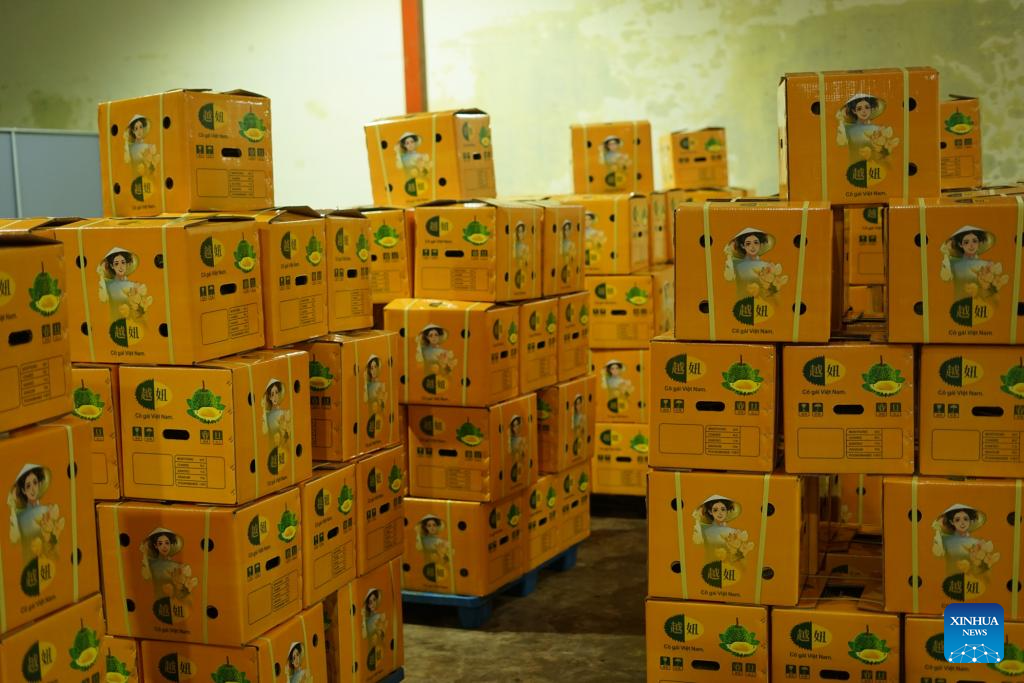
Packed fresh durians wait to be delivered at a durian processing plant in Dak Lak province, Vietnam, on Sept. 15, 2023. Dak Lak is a leading durian-growing province in the country. As the vast majority of durians sold in the Chinese market are imported from Southeast Asia, the "king of fruits" has emerged as a prominent symbol of the booming China-ASEAN cooperation and China's vast market potential.
The flow of goods in this regional market has continued to benefit from tariff-free policies and expanded market access under the frameworks of the China-ASEAN Free Trade Area and the Regional Comprehensive Economic Partnership (RCEP).
In the first five months of this year, Guangxi imported 3.66 billion yuan worth of fruits from ASEAN countries, a marked rise of 194 percent year on year. Among the most notable increases is durian, which surged 516 percent from the same period last year, according to customs data. (Xinhua/Hu Jiali)

Packed durians are loaded into a truck at a durian plant in Chumphon, Thailand, Sept. 19, 2023. According to data from Thailand's Ministry of Commerce, China was the largest export market for Thai durians in 2022, accounting for more than 96 percent of the total export volume. As the vast majority of durians sold in the Chinese market are imported from Southeast Asia, the "king of fruits" has emerged as a prominent symbol of the booming China-ASEAN cooperation and China's vast market potential.
The flow of goods in this regional market has continued to benefit from tariff-free policies and expanded market access under the frameworks of the China-ASEAN Free Trade Area and the Regional Comprehensive Economic Partnership (RCEP).
In the first five months of this year, Guangxi imported 3.66 billion yuan worth of fruits from ASEAN countries, a marked rise of 194 percent year on year. Among the most notable increases is durian, which surged 516 percent from the same period last year, according to customs data. (Xinhua/Wang Teng)

A worker catches a durian cut off from a tree at an orchard in Chumphon, Thailand, Sept. 18, 2023. According to data from Thailand's Ministry of Commerce, China was the largest export market for Thai durians in 2022, accounting for more than 96 percent of the total export volume. As the vast majority of durians sold in the Chinese market are imported from Southeast Asia, the "king of fruits" has emerged as a prominent symbol of the booming China-ASEAN cooperation and China's vast market potential.
The flow of goods in this regional market has continued to benefit from tariff-free policies and expanded market access under the frameworks of the China-ASEAN Free Trade Area and the Regional Comprehensive Economic Partnership (RCEP).
In the first five months of this year, Guangxi imported 3.66 billion yuan worth of fruits from ASEAN countries, a marked rise of 194 percent year on year. Among the most notable increases is durian, which surged 516 percent from the same period last year, according to customs data. (Xinhua/Wang Teng)

This aerial photo taken on Sept. 18, 2023 shows a durian orchard in Chumphon, Thailand. According to data from Thailand's Ministry of Commerce, China was the largest export market for Thai durians in 2022, accounting for more than 96 percent of the total export volume. As the vast majority of durians sold in the Chinese market are imported from Southeast Asia, the "king of fruits" has emerged as a prominent symbol of the booming China-ASEAN cooperation and China's vast market potential.
The flow of goods in this regional market has continued to benefit from tariff-free policies and expanded market access under the frameworks of the China-ASEAN Free Trade Area and the Regional Comprehensive Economic Partnership (RCEP).
In the first five months of this year, Guangxi imported 3.66 billion yuan worth of fruits from ASEAN countries, a marked rise of 194 percent year on year. Among the most notable increases is durian, which surged 516 percent from the same period last year, according to customs data. (Xinhua/Wang Teng)

A worker catches a durian cut off from a tree at an orchard in Chumphon, Thailand, Sept. 18, 2023. According to data from Thailand's Ministry of Commerce, China was the largest export market for Thai durians in 2022, accounting for more than 96 percent of the total export volume. As the vast majority of durians sold in the Chinese market are imported from Southeast Asia, the "king of fruits" has emerged as a prominent symbol of the booming China-ASEAN cooperation and China's vast market potential.
The flow of goods in this regional market has continued to benefit from tariff-free policies and expanded market access under the frameworks of the China-ASEAN Free Trade Area and the Regional Comprehensive Economic Partnership (RCEP).
In the first five months of this year, Guangxi imported 3.66 billion yuan worth of fruits from ASEAN countries, a marked rise of 194 percent year on year. Among the most notable increases is durian, which surged 516 percent from the same period last year, according to customs data. (Xinhua/Wang Teng)
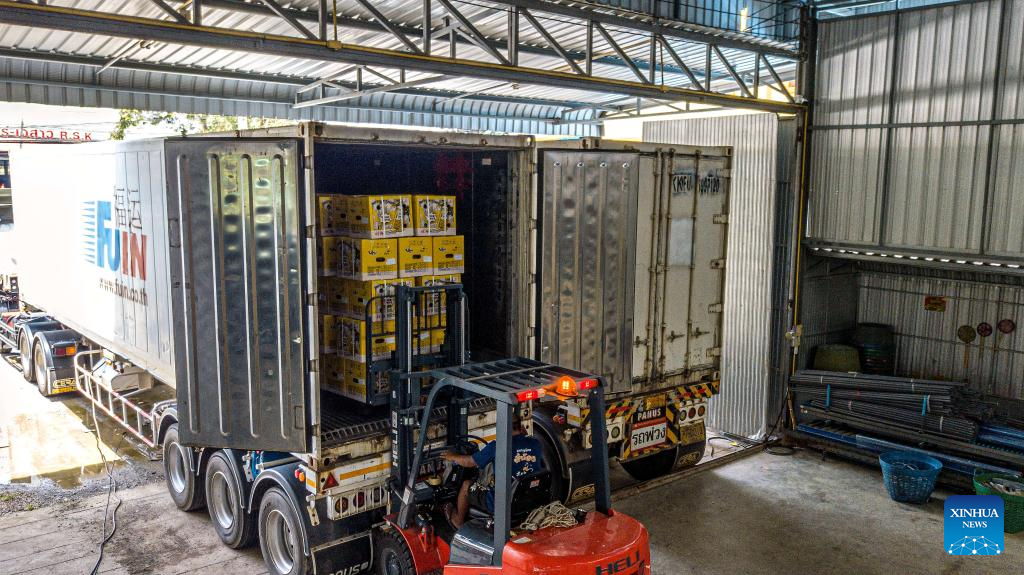
A staff member loads packed durians into a truck at a durian plant in Chumphon, Thailand, Sept. 19, 2023. According to data from Thailand's Ministry of Commerce, China was the largest export market for Thai durians in 2022, accounting for more than 96 percent of the total export volume. As the vast majority of durians sold in the Chinese market are imported from Southeast Asia, the "king of fruits" has emerged as a prominent symbol of the booming China-ASEAN cooperation and China's vast market potential.
The flow of goods in this regional market has continued to benefit from tariff-free policies and expanded market access under the frameworks of the China-ASEAN Free Trade Area and the Regional Comprehensive Economic Partnership (RCEP).
In the first five months of this year, Guangxi imported 3.66 billion yuan worth of fruits from ASEAN countries, a marked rise of 194 percent year on year. Among the most notable increases is durian, which surged 516 percent from the same period last year, according to customs data. (Xinhua/Wang Teng)
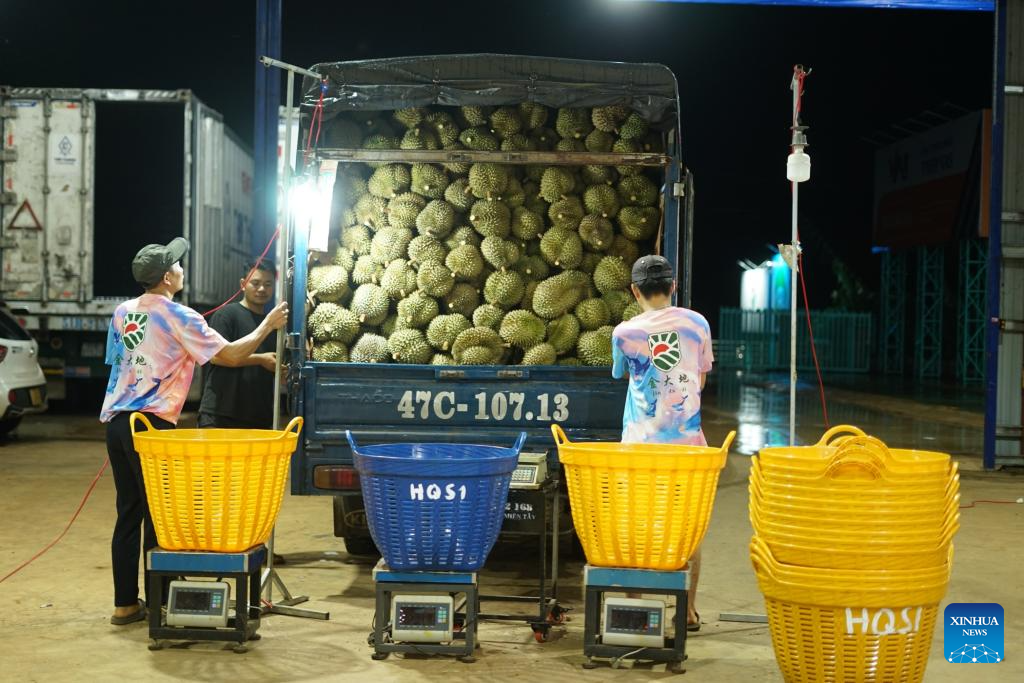
Staff members prepare to unload fresh durians at a durian processing plant in Dak Lak province, Vietnam, on Sept. 15, 2023. Dak Lak is a leading durian-growing province in the country. As the vast majority of durians sold in the Chinese market are imported from Southeast Asia, the "king of fruits" has emerged as a prominent symbol of the booming China-ASEAN cooperation and China's vast market potential.
The flow of goods in this regional market has continued to benefit from tariff-free policies and expanded market access under the frameworks of the China-ASEAN Free Trade Area and the Regional Comprehensive Economic Partnership (RCEP).
In the first five months of this year, Guangxi imported 3.66 billion yuan worth of fruits from ASEAN countries, a marked rise of 194 percent year on year. Among the most notable increases is durian, which surged 516 percent from the same period last year, according to customs data. (Xinhua/Hu Jiali)

A farmer loads freshly harvested durians into a cart at a durian orchard in Dak Lak province, Vietnam, on Sept. 15, 2023. Dak Lak is a leading durian-growing province in the country. As the vast majority of durians sold in the Chinese market are imported from Southeast Asia, the "king of fruits" has emerged as a prominent symbol of the booming China-ASEAN cooperation and China's vast market potential.
The flow of goods in this regional market has continued to benefit from tariff-free policies and expanded market access under the frameworks of the China-ASEAN Free Trade Area and the Regional Comprehensive Economic Partnership (RCEP).
In the first five months of this year, Guangxi imported 3.66 billion yuan worth of fruits from ASEAN countries, a marked rise of 194 percent year on year. Among the most notable increases is durian, which surged 516 percent from the same period last year, according to customs data. (Xinhua/Hu Jiali)

A farmer harvests durians at a durian orchard in Dak Lak province, Vietnam, on Sept. 15, 2023. Dak Lak is a leading durian-growing province in the country. As the vast majority of durians sold in the Chinese market are imported from Southeast Asia, the "king of fruits" has emerged as a prominent symbol of the booming China-ASEAN cooperation and China's vast market potential.
The flow of goods in this regional market has continued to benefit from tariff-free policies and expanded market access under the frameworks of the China-ASEAN Free Trade Area and the Regional Comprehensive Economic Partnership (RCEP).
In the first five months of this year, Guangxi imported 3.66 billion yuan worth of fruits from ASEAN countries, a marked rise of 194 percent year on year. Among the most notable increases is durian, which surged 516 percent from the same period last year, according to customs data. (Photo by Pham Dinh Duc/Xinhua)
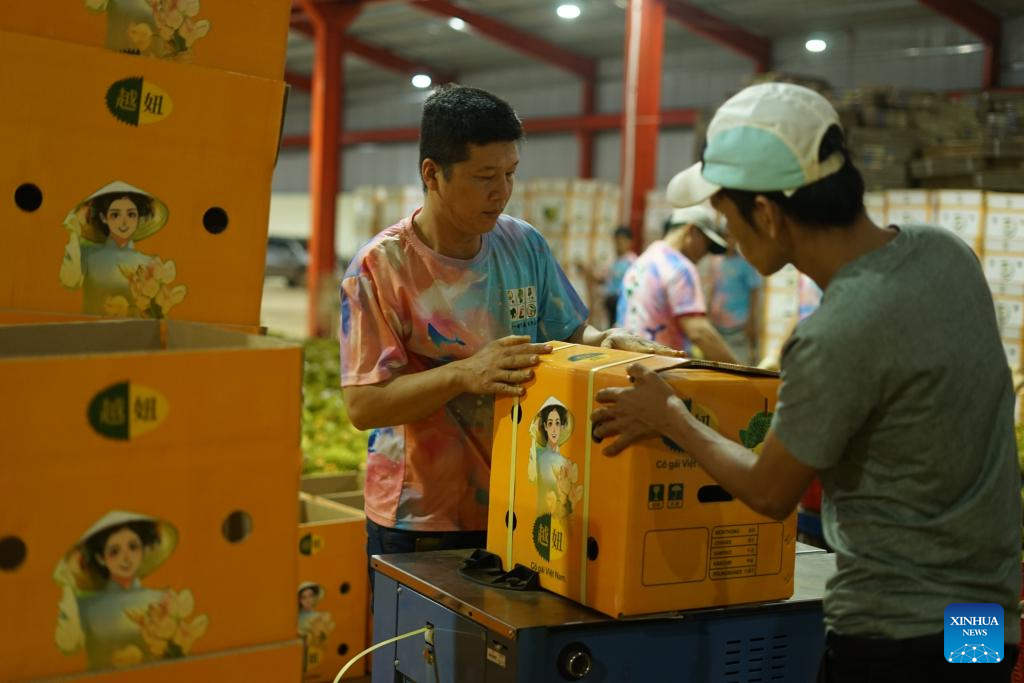
Staff members pack durians to be exported to China at a durian processing plant in Dak Lak province, Vietnam, on Sept. 15, 2023. Dak Lak is a leading durian-growing province in the country. As the vast majority of durians sold in the Chinese market are imported from Southeast Asia, the "king of fruits" has emerged as a prominent symbol of the booming China-ASEAN cooperation and China's vast market potential.
The flow of goods in this regional market has continued to benefit from tariff-free policies and expanded market access under the frameworks of the China-ASEAN Free Trade Area and the Regional Comprehensive Economic Partnership (RCEP).
In the first five months of this year, Guangxi imported 3.66 billion yuan worth of fruits from ASEAN countries, a marked rise of 194 percent year on year. Among the most notable increases is durian, which surged 516 percent from the same period last year, according to customs data. (Xinhua/Hu Jiali)

A staff member weighs durians at a durian processing plant in Dak Lak province, Vietnam, on Sept. 15, 2023. Dak Lak is a leading durian-growing province in the country. As the vast majority of durians sold in the Chinese market are imported from Southeast Asia, the "king of fruits" has emerged as a prominent symbol of the booming China-ASEAN cooperation and China's vast market potential.
The flow of goods in this regional market has continued to benefit from tariff-free policies and expanded market access under the frameworks of the China-ASEAN Free Trade Area and the Regional Comprehensive Economic Partnership (RCEP).
In the first five months of this year, Guangxi imported 3.66 billion yuan worth of fruits from ASEAN countries, a marked rise of 194 percent year on year. Among the most notable increases is durian, which surged 516 percent from the same period last year, according to customs data. (Photo by Pham Dinh Duc/Xinhua)

A worker transports freshly harvested durians at an orchard in Chumphon, Thailand, Sept. 18, 2023. According to data from Thailand's Ministry of Commerce, China was the largest export market for Thai durians in 2022, accounting for more than 96 percent of the total export volume. As the vast majority of durians sold in the Chinese market are imported from Southeast Asia, the "king of fruits" has emerged as a prominent symbol of the booming China-ASEAN cooperation and China's vast market potential.
The flow of goods in this regional market has continued to benefit from tariff-free policies and expanded market access under the frameworks of the China-ASEAN Free Trade Area and the Regional Comprehensive Economic Partnership (RCEP).
In the first five months of this year, Guangxi imported 3.66 billion yuan worth of fruits from ASEAN countries, a marked rise of 194 percent year on year. Among the most notable increases is durian, which surged 516 percent from the same period last year, according to customs data. (Xinhua/Wang Teng)
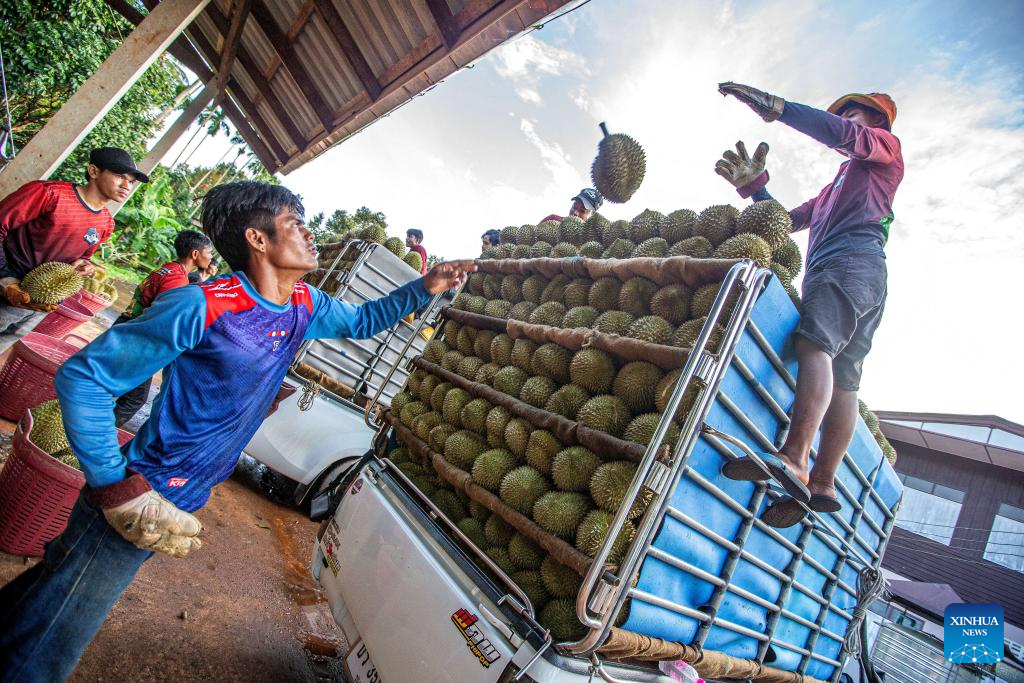
Workers load freshly harvested durians at an orchard in Chumphon, Thailand, Sept. 18, 2023. According to data from Thailand's Ministry of Commerce, China was the largest export market for Thai durians in 2022, accounting for more than 96 percent of the total export volume. As the vast majority of durians sold in the Chinese market are imported from Southeast Asia, the "king of fruits" has emerged as a prominent symbol of the booming China-ASEAN cooperation and China's vast market potential.
The flow of goods in this regional market has continued to benefit from tariff-free policies and expanded market access under the frameworks of the China-ASEAN Free Trade Area and the Regional Comprehensive Economic Partnership (RCEP).
In the first five months of this year, Guangxi imported 3.66 billion yuan worth of fruits from ASEAN countries, a marked rise of 194 percent year on year. Among the most notable increases is durian, which surged 516 percent from the same period last year, according to customs data. (Xinhua/Wang Teng)
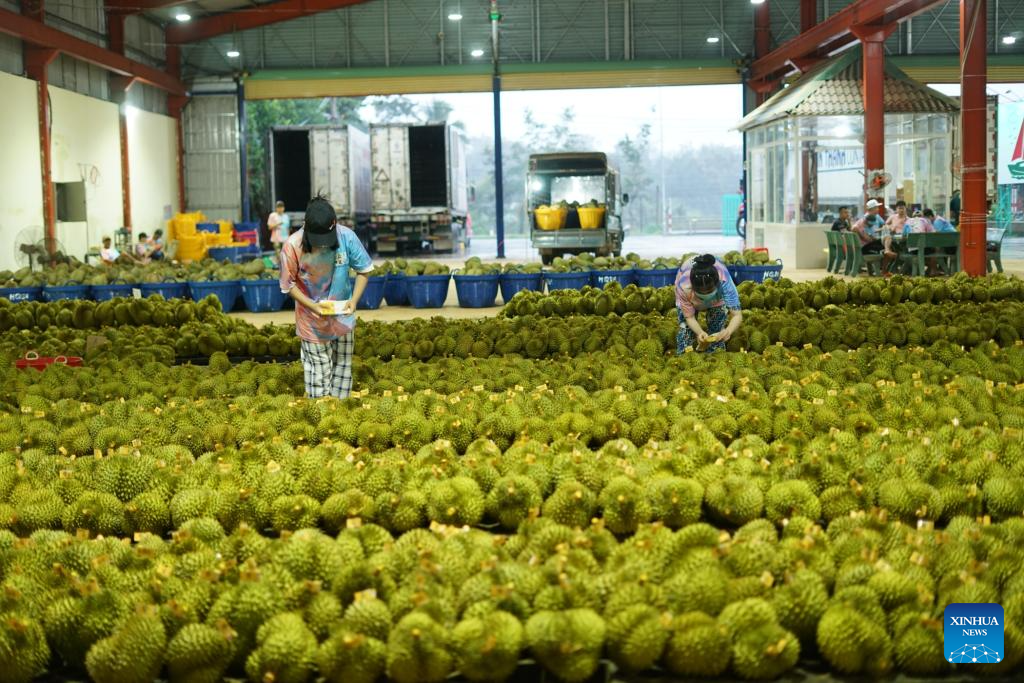
Staff members label durians to be exported to China at a durian processing plant in Dak Lak province, Vietnam, on Sept. 15, 2023. Dak Lak is a leading durian-growing province in the country. As the vast majority of durians sold in the Chinese market are imported from Southeast Asia, the "king of fruits" has emerged as a prominent symbol of the booming China-ASEAN cooperation and China's vast market potential.
The flow of goods in this regional market has continued to benefit from tariff-free policies and expanded market access under the frameworks of the China-ASEAN Free Trade Area and the Regional Comprehensive Economic Partnership (RCEP).
In the first five months of this year, Guangxi imported 3.66 billion yuan worth of fruits from ASEAN countries, a marked rise of 194 percent year on year. Among the most notable increases is durian, which surged 516 percent from the same period last year, according to customs data. (Xinhua/Hu Jiali)
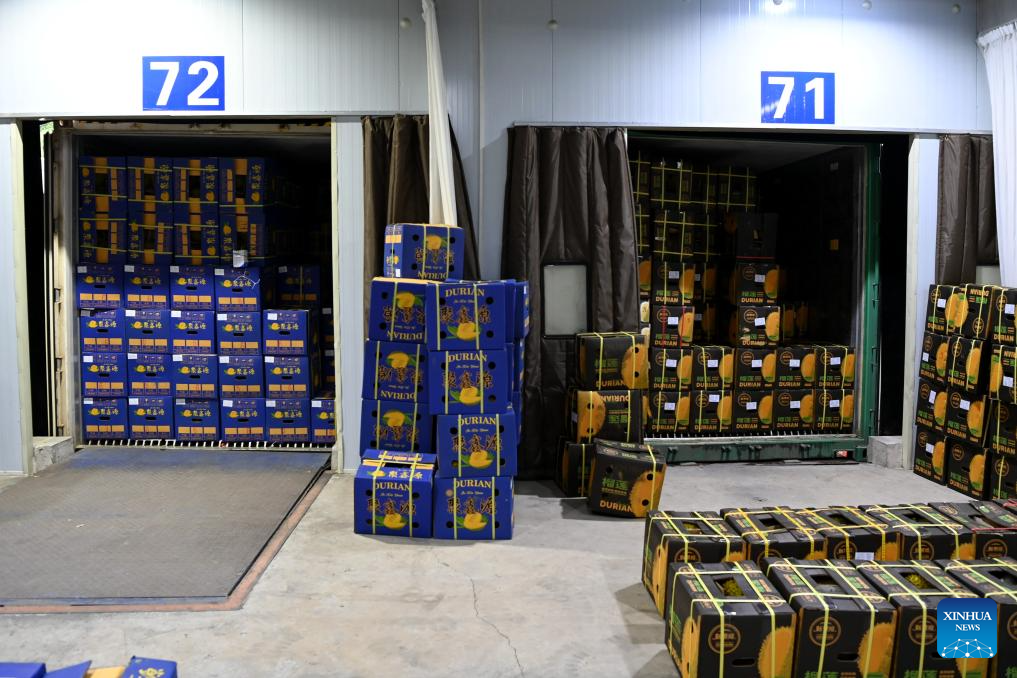
This photo taken on Sept. 12, 2023 shows part of durians waiting for custom clearance at the port of the Friendship Pass in Pingxiang, south China's Guangxi Zhuang Autonomous Region. As the vast majority of durians sold in the Chinese market are imported from Southeast Asia, the "king of fruits" has emerged as a prominent symbol of the booming China-ASEAN cooperation and China's vast market potential.
The flow of goods in this regional market has continued to benefit from tariff-free policies and expanded market access under the frameworks of the China-ASEAN Free Trade Area and the Regional Comprehensive Economic Partnership (RCEP).
In the first five months of this year, Guangxi imported 3.66 billion yuan worth of fruits from ASEAN countries, a marked rise of 194 percent year on year. Among the most notable increases is durian, which surged 516 percent from the same period last year, according to customs data. (Xinhua/Cao Yiming)
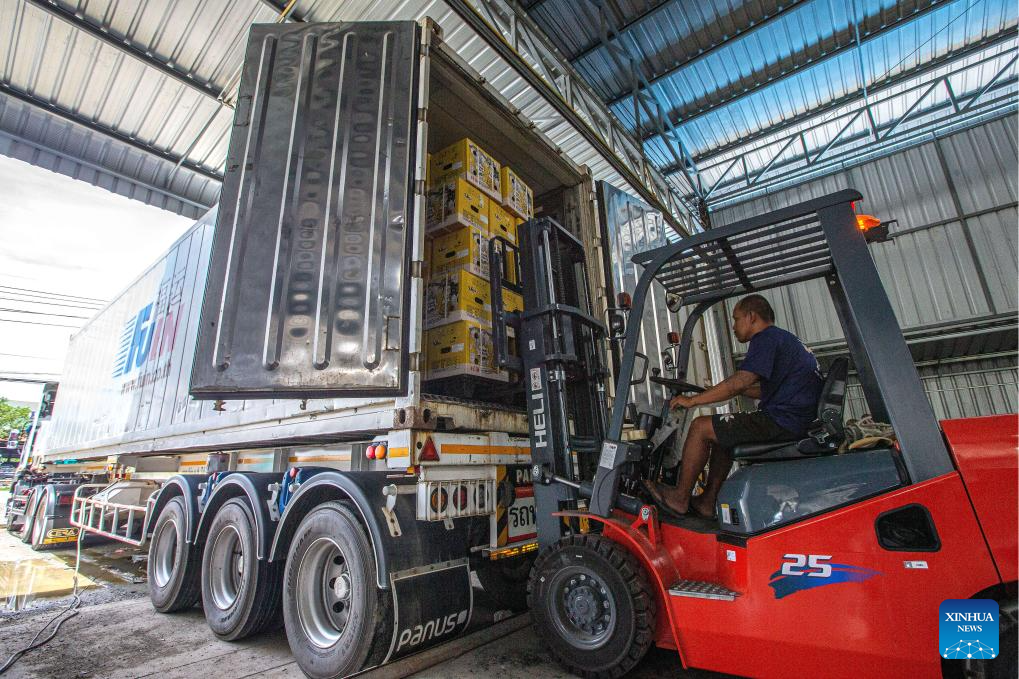
A staff member loads packed durians into a truck at a durian plant in Chumphon, Thailand, Sept. 19, 2023. According to data from Thailand's Ministry of Commerce, China was the largest export market for Thai durians in 2022, accounting for more than 96 percent of the total export volume. As the vast majority of durians sold in the Chinese market are imported from Southeast Asia, the "king of fruits" has emerged as a prominent symbol of the booming China-ASEAN cooperation and China's vast market potential.
The flow of goods in this regional market has continued to benefit from tariff-free policies and expanded market access under the frameworks of the China-ASEAN Free Trade Area and the Regional Comprehensive Economic Partnership (RCEP).
In the first five months of this year, Guangxi imported 3.66 billion yuan worth of fruits from ASEAN countries, a marked rise of 194 percent year on year. Among the most notable increases is durian, which surged 516 percent from the same period last year, according to customs data. (Xinhua/Wang Teng)
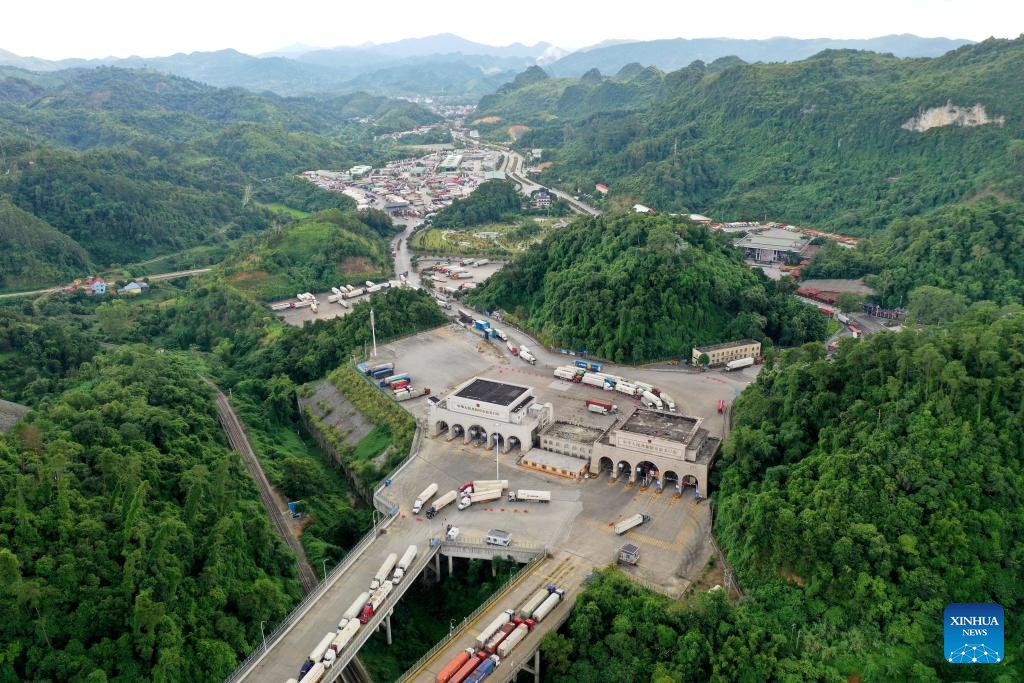
This aerial photo taken on Sept. 9, 2023 shows a view of the port of the Friendship Pass in Pingxiang, south China's Guangxi Zhuang Autonomous Region. As the vast majority of durians sold in the Chinese market are imported from Southeast Asia, the "king of fruits" has emerged as a prominent symbol of the booming China-ASEAN cooperation and China's vast market potential.
The flow of goods in this regional market has continued to benefit from tariff-free policies and expanded market access under the frameworks of the China-ASEAN Free Trade Area and the Regional Comprehensive Economic Partnership (RCEP).
In the first five months of this year, Guangxi imported 3.66 billion yuan worth of fruits from ASEAN countries, a marked rise of 194 percent year on year. Among the most notable increases is durian, which surged 516 percent from the same period last year, according to customs data. (Xinhua/Cao Yiming)

A staff member moves durians waiting for custom clearance at the port of the Friendship Pass in Pingxiang, south China's Guangxi Zhuang Autonomous Region, on Sept. 12, 2023. As the vast majority of durians sold in the Chinese market are imported from Southeast Asia, the "king of fruits" has emerged as a prominent symbol of the booming China-ASEAN cooperation and China's vast market potential.
The flow of goods in this regional market has continued to benefit from tariff-free policies and expanded market access under the frameworks of the China-ASEAN Free Trade Area and the Regional Comprehensive Economic Partnership (RCEP).
In the first five months of this year, Guangxi imported 3.66 billion yuan worth of fruits from ASEAN countries, a marked rise of 194 percent year on year. Among the most notable increases is durian, which surged 516 percent from the same period last year, according to customs data. (Xinhua/Cao Yiming)

A staff member (L) processes custom clearance documents at the port of the Friendship Pass in Pingxiang, south China's Guangxi Zhuang Autonomous Region, on Sept. 12, 2023. As the vast majority of durians sold in the Chinese market are imported from Southeast Asia, the "king of fruits" has emerged as a prominent symbol of the booming China-ASEAN cooperation and China's vast market potential.
The flow of goods in this regional market has continued to benefit from tariff-free policies and expanded market access under the frameworks of the China-ASEAN Free Trade Area and the Regional Comprehensive Economic Partnership (RCEP).
In the first five months of this year, Guangxi imported 3.66 billion yuan worth of fruits from ASEAN countries, a marked rise of 194 percent year on year. Among the most notable increases is durian, which surged 516 percent from the same period last year, according to customs data. (Xinhua/Cao Yiming)

A worker cuts durians off from a tree at an orchard in Chumphon, Thailand, Sept. 18, 2023. According to data from Thailand's Ministry of Commerce, China was the largest export market for Thai durians in 2022, accounting for more than 96 percent of the total export volume. As the vast majority of durians sold in the Chinese market are imported from Southeast Asia, the "king of fruits" has emerged as a prominent symbol of the booming China-ASEAN cooperation and China's vast market potential.
The flow of goods in this regional market has continued to benefit from tariff-free policies and expanded market access under the frameworks of the China-ASEAN Free Trade Area and the Regional Comprehensive Economic Partnership (RCEP).
In the first five months of this year, Guangxi imported 3.66 billion yuan worth of fruits from ASEAN countries, a marked rise of 194 percent year on year. Among the most notable increases is durian, which surged 516 percent from the same period last year, according to customs data. (Xinhua/Wang Teng)
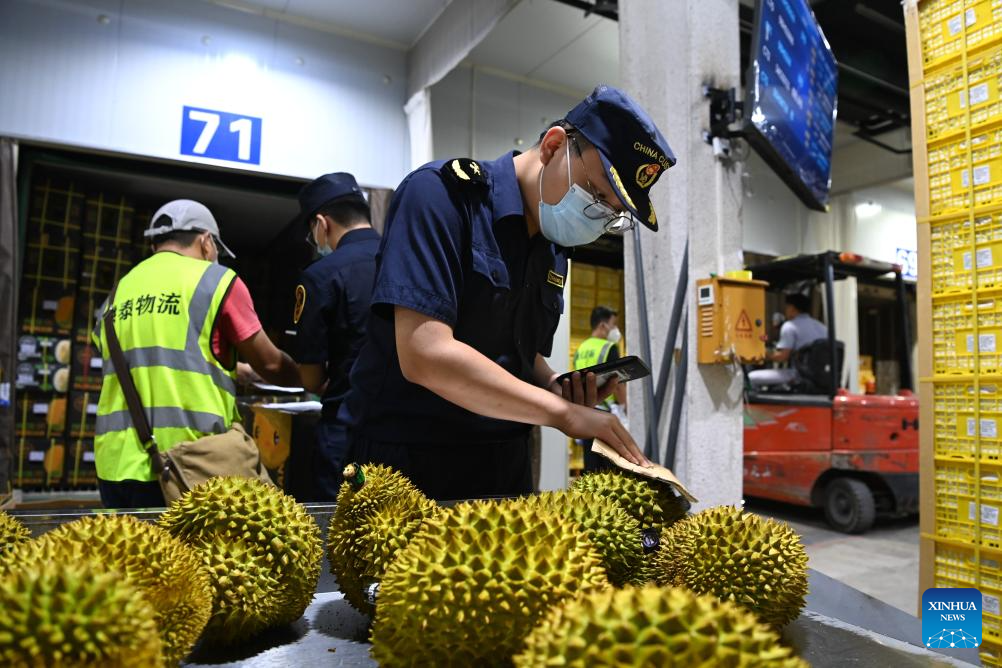
Custom staff members check imported durians at the port of the Friendship Pass in Pingxiang, south China's Guangxi Zhuang Autonomous Region, on Sept. 12, 2023. As the vast majority of durians sold in the Chinese market are imported from Southeast Asia, the "king of fruits" has emerged as a prominent symbol of the booming China-ASEAN cooperation and China's vast market potential.
The flow of goods in this regional market has continued to benefit from tariff-free policies and expanded market access under the frameworks of the China-ASEAN Free Trade Area and the Regional Comprehensive Economic Partnership (RCEP).
In the first five months of this year, Guangxi imported 3.66 billion yuan worth of fruits from ASEAN countries, a marked rise of 194 percent year on year. Among the most notable increases is durian, which surged 516 percent from the same period last year, according to customs data. (Xinhua/Cao Yiming)

Custom staff members check imported durians at the port of the Friendship Pass in Pingxiang, south China's Guangxi Zhuang Autonomous Region, on Sept. 12, 2023. As the vast majority of durians sold in the Chinese market are imported from Southeast Asia, the "king of fruits" has emerged as a prominent symbol of the booming China-ASEAN cooperation and China's vast market potential.
The flow of goods in this regional market has continued to benefit from tariff-free policies and expanded market access under the frameworks of the China-ASEAN Free Trade Area and the Regional Comprehensive Economic Partnership (RCEP).
In the first five months of this year, Guangxi imported 3.66 billion yuan worth of fruits from ASEAN countries, a marked rise of 194 percent year on year. Among the most notable increases is durian, which surged 516 percent from the same period last year, according to customs data. (Xinhua/Cao Yiming)
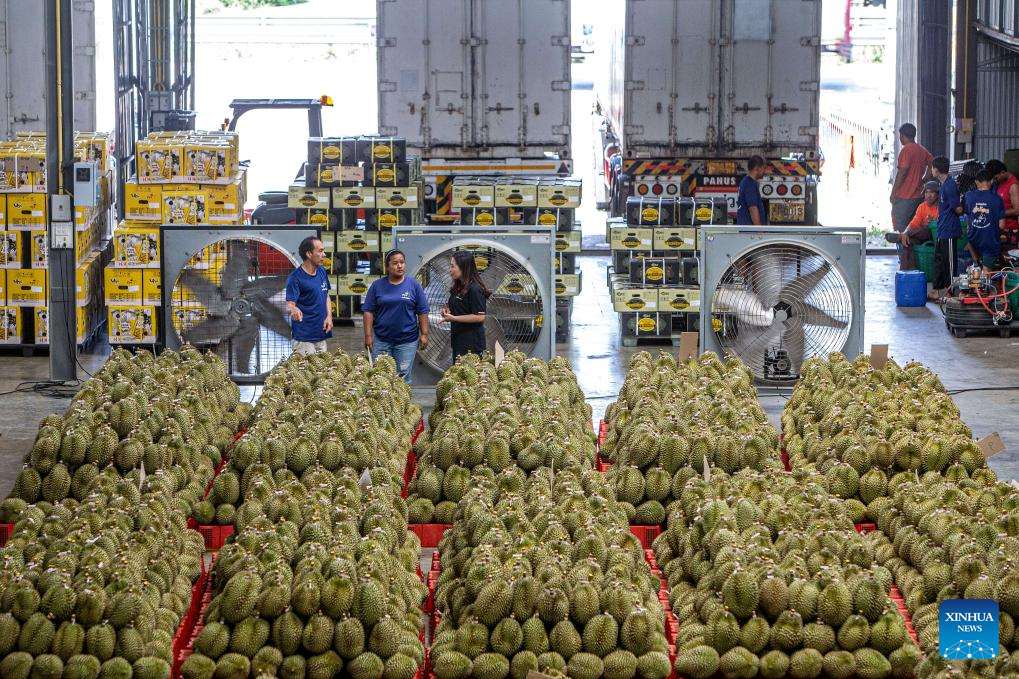
Staff members check freshly harvested durians at a durian plant in Chumphon, Thailand, Sept. 19, 2023. According to data from Thailand's Ministry of Commerce, China was the largest export market for Thai durians in 2022, accounting for more than 96 percent of the total export volume. As the vast majority of durians sold in the Chinese market are imported from Southeast Asia, the "king of fruits" has emerged as a prominent symbol of the booming China-ASEAN cooperation and China's vast market potential.
The flow of goods in this regional market has continued to benefit from tariff-free policies and expanded market access under the frameworks of the China-ASEAN Free Trade Area and the Regional Comprehensive Economic Partnership (RCEP).
In the first five months of this year, Guangxi imported 3.66 billion yuan worth of fruits from ASEAN countries, a marked rise of 194 percent year on year. Among the most notable increases is durian, which surged 516 percent from the same period last year, according to customs data. (Xinhua/Wang Teng)

A worker waits to catch durians cut off from a tree at an orchard in Chumphon, Thailand, Sept. 18, 2023. According to data from Thailand's Ministry of Commerce, China was the largest export market for Thai durians in 2022, accounting for more than 96 percent of the total export volume. As the vast majority of durians sold in the Chinese market are imported from Southeast Asia, the "king of fruits" has emerged as a prominent symbol of the booming China-ASEAN cooperation and China's vast market potential.
The flow of goods in this regional market has continued to benefit from tariff-free policies and expanded market access under the frameworks of the China-ASEAN Free Trade Area and the Regional Comprehensive Economic Partnership (RCEP).
In the first five months of this year, Guangxi imported 3.66 billion yuan worth of fruits from ASEAN countries, a marked rise of 194 percent year on year. Among the most notable increases is durian, which surged 516 percent from the same period last year, according to customs data. (Xinhua/Wang Teng)

Vietnamese vendors sell durians in Dongxing, south China's Guangxi Zhuang Autonomous Region, on May 18, 2023. As the vast majority of durians sold in the Chinese market are imported from Southeast Asia, the "king of fruits" has emerged as a prominent symbol of the booming China-ASEAN cooperation and China's vast market potential.
The flow of goods in this regional market has continued to benefit from tariff-free policies and expanded market access under the frameworks of the China-ASEAN Free Trade Area and the Regional Comprehensive Economic Partnership (RCEP).
In the first five months of this year, Guangxi imported 3.66 billion yuan worth of fruits from ASEAN countries, a marked rise of 194 percent year on year. Among the most notable increases is durian, which surged 516 percent from the same period last year, according to customs data. (Xinhua/Hu Xingyu)

Vietnamese vendors sell durians in Dongxing, south China's Guangxi Zhuang Autonomous Region, on May 18, 2023. As the vast majority of durians sold in the Chinese market are imported from Southeast Asia, the "king of fruits" has emerged as a prominent symbol of the booming China-ASEAN cooperation and China's vast market potential.
The flow of goods in this regional market has continued to benefit from tariff-free policies and expanded market access under the frameworks of the China-ASEAN Free Trade Area and the Regional Comprehensive Economic Partnership (RCEP).
In the first five months of this year, Guangxi imported 3.66 billion yuan worth of fruits from ASEAN countries, a marked rise of 194 percent year on year. Among the most notable increases is durian, which surged 516 percent from the same period last year, according to customs data. (Xinhua/Hu Xingyu)
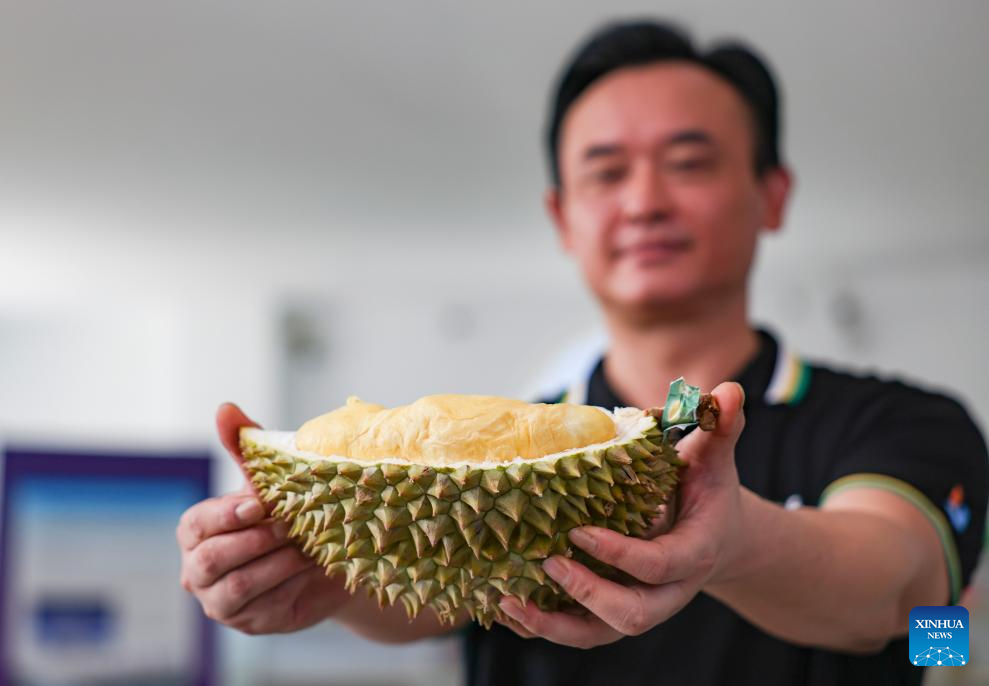
A staff member of a fruit trading company presents an opened durian imported from Vietnam in Pingxiang, south China's Guangxi Zhuang Autonomous Region, on May 19, 2023. As the vast majority of durians sold in the Chinese market are imported from Southeast Asia, the "king of fruits" has emerged as a prominent symbol of the booming China-ASEAN cooperation and China's vast market potential.
The flow of goods in this regional market has continued to benefit from tariff-free policies and expanded market access under the frameworks of the China-ASEAN Free Trade Area and the Regional Comprehensive Economic Partnership (RCEP).
In the first five months of this year, Guangxi imported 3.66 billion yuan worth of fruits from ASEAN countries, a marked rise of 194 percent year on year. Among the most notable increases is durian, which surged 516 percent from the same period last year, according to customs data. (Xinhua/Hu Xingyu)
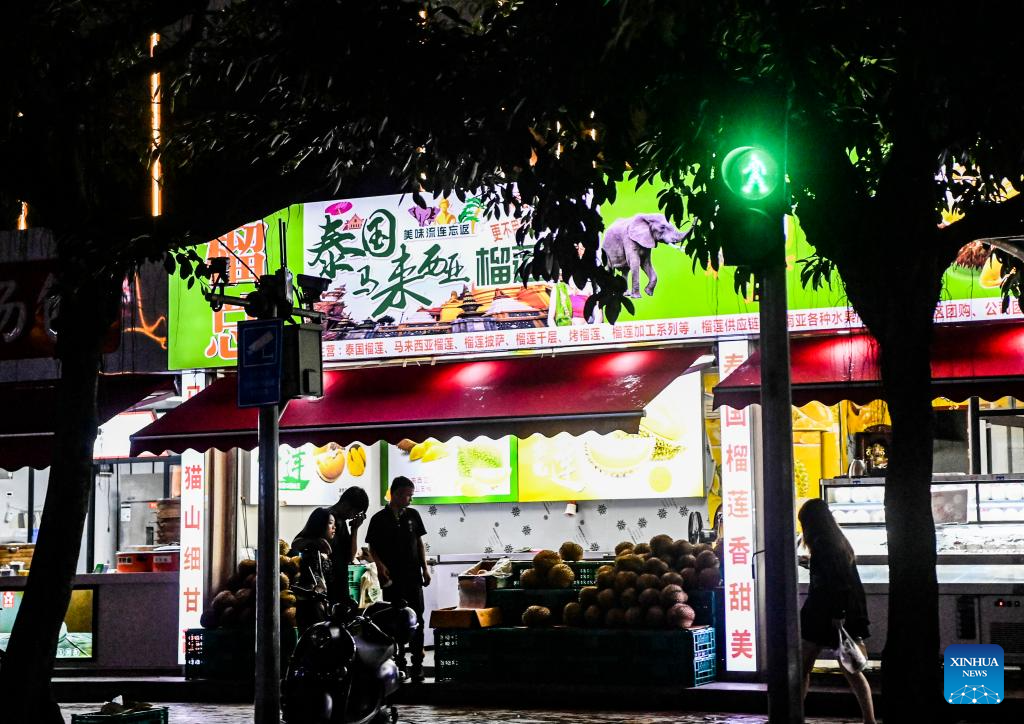
This photo taken on Sept. 17, 2023 shows a shop selling durian products in Nanning, south China's Guangxi Zhuang Autonomous Region. As the vast majority of durians sold in the Chinese market are imported from Southeast Asia, the "king of fruits" has emerged as a prominent symbol of the booming China-ASEAN cooperation and China's vast market potential.
The flow of goods in this regional market has continued to benefit from tariff-free policies and expanded market access under the frameworks of the China-ASEAN Free Trade Area and the Regional Comprehensive Economic Partnership (RCEP).
In the first five months of this year, Guangxi imported 3.66 billion yuan worth of fruits from ASEAN countries, a marked rise of 194 percent year on year. Among the most notable increases is durian, which surged 516 percent from the same period last year, according to customs data. (Xinhua/Hu Xingyu)
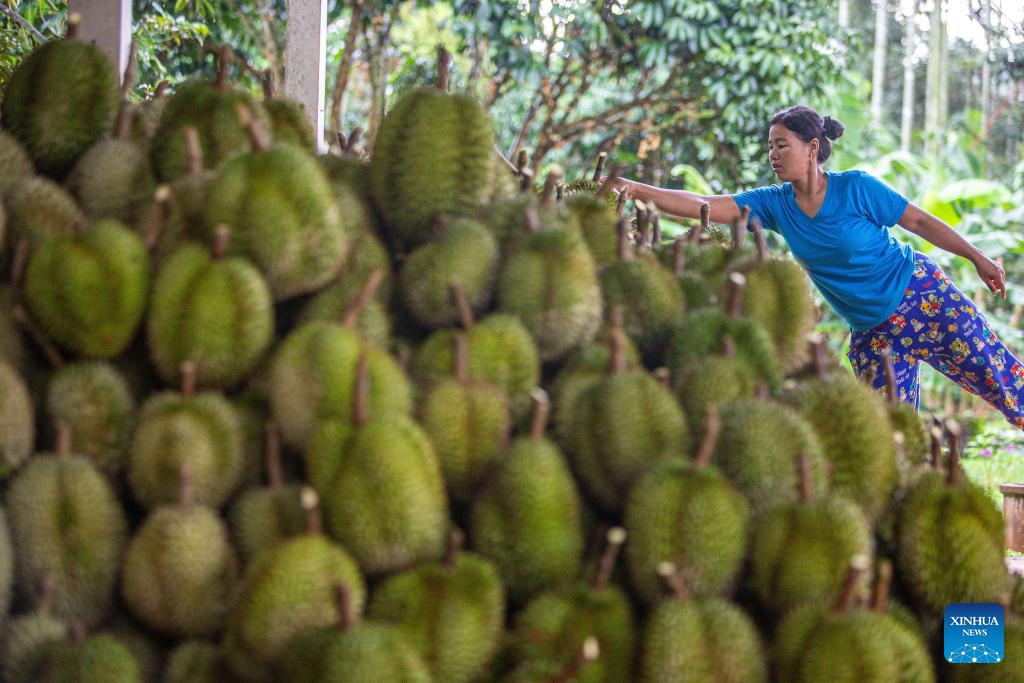
A worker piles freshly harvested durians at an orchard in Chumphon, Thailand, Sept. 18, 2023. According to data from Thailand's Ministry of Commerce, China was the largest export market for Thai durians in 2022, accounting for more than 96 percent of the total export volume. As the vast majority of durians sold in the Chinese market are imported from Southeast Asia, the "king of fruits" has emerged as a prominent symbol of the booming China-ASEAN cooperation and China's vast market potential.
The flow of goods in this regional market has continued to benefit from tariff-free policies and expanded market access under the frameworks of the China-ASEAN Free Trade Area and the Regional Comprehensive Economic Partnership (RCEP).
In the first five months of this year, Guangxi imported 3.66 billion yuan worth of fruits from ASEAN countries, a marked rise of 194 percent year on year. Among the most notable increases is durian, which surged 516 percent from the same period last year, according to customs data. (Xinhua/Wang Teng)

A costomer takes photos of durian-flavored dessert at a snack shop in Nanning, south China's Guangxi Zhuang Autonomous Region, on Sept. 17, 2023. As the vast majority of durians sold in the Chinese market are imported from Southeast Asia, the "king of fruits" has emerged as a prominent symbol of the booming China-ASEAN cooperation and China's vast market potential.
The flow of goods in this regional market has continued to benefit from tariff-free policies and expanded market access under the frameworks of the China-ASEAN Free Trade Area and the Regional Comprehensive Economic Partnership (RCEP).
In the first five months of this year, Guangxi imported 3.66 billion yuan worth of fruits from ASEAN countries, a marked rise of 194 percent year on year. Among the most notable increases is durian, which surged 516 percent from the same period last year, according to customs data. (Xinhua/Cao Yiming)
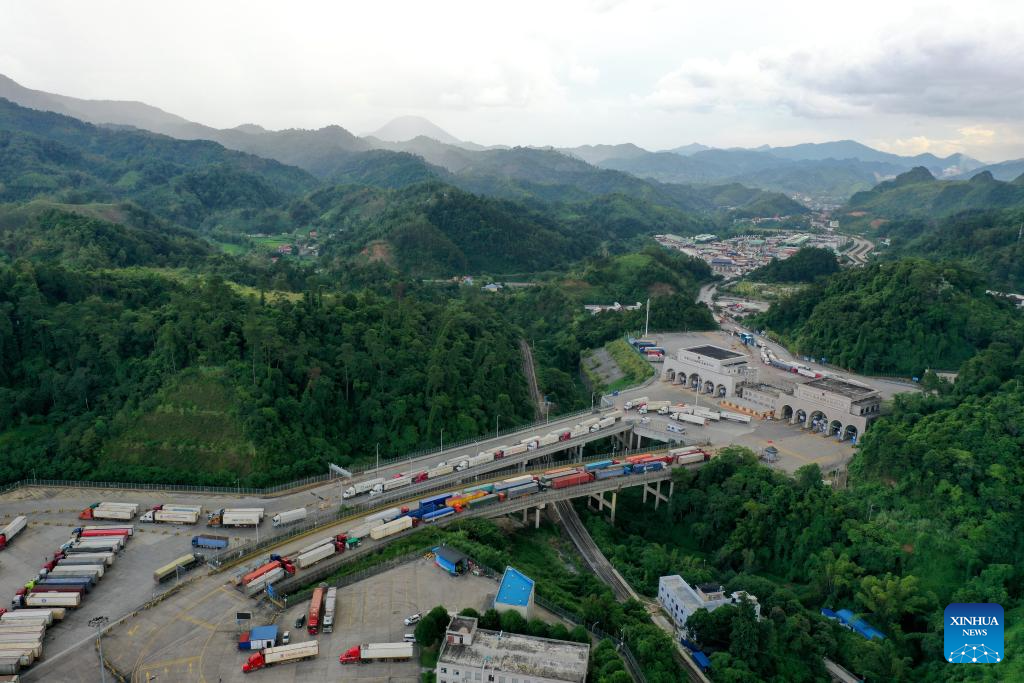
This aerial photo taken on Sept. 9, 2023 shows a view of the port of the Friendship Pass in Pingxiang, south China's Guangxi Zhuang Autonomous Region. As the vast majority of durians sold in the Chinese market are imported from Southeast Asia, the "king of fruits" has emerged as a prominent symbol of the booming China-ASEAN cooperation and China's vast market potential.
The flow of goods in this regional market has continued to benefit from tariff-free policies and expanded market access under the frameworks of the China-ASEAN Free Trade Area and the Regional Comprehensive Economic Partnership (RCEP).
In the first five months of this year, Guangxi imported 3.66 billion yuan worth of fruits from ASEAN countries, a marked rise of 194 percent year on year. Among the most notable increases is durian, which surged 516 percent from the same period last year, according to customs data. (Xinhua/Cao Yiming)
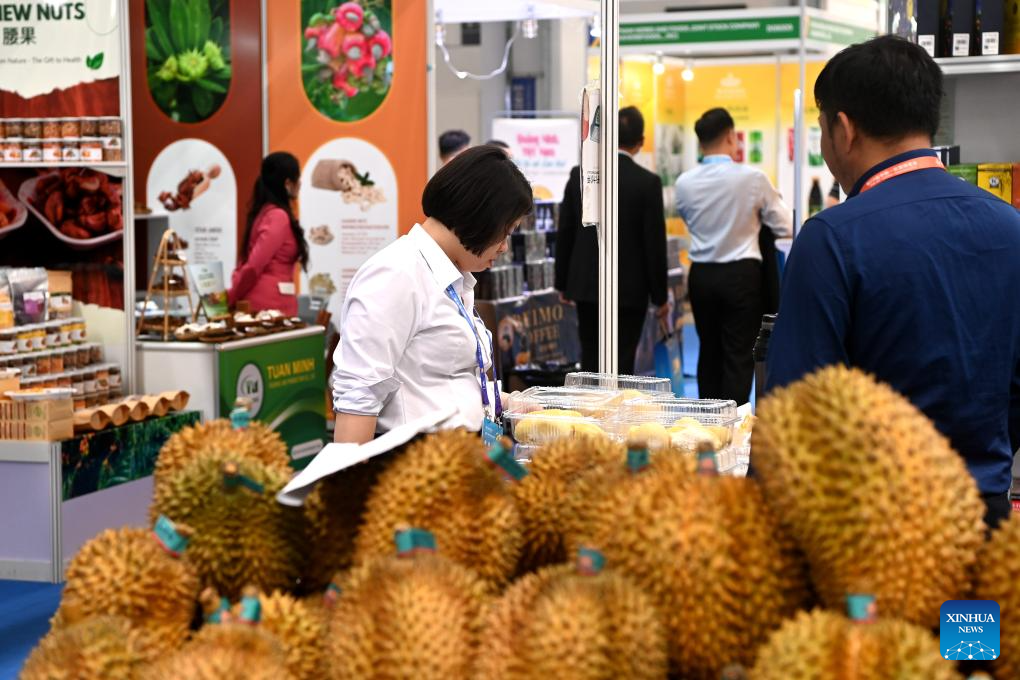
A visitor (L, front) chooses durian imported from Vietnam during the 20th China-ASEAN Expo at Nanning International Convention and Exhibition Center in Nanning, capital of south China's Guangxi Zhuang Autonomous Region, Sept. 17, 2023. As the vast majority of durians sold in the Chinese market are imported from Southeast Asia, the "king of fruits" has emerged as a prominent symbol of the booming China-ASEAN cooperation and China's vast market potential.
The flow of goods in this regional market has continued to benefit from tariff-free policies and expanded market access under the frameworks of the China-ASEAN Free Trade Area and the Regional Comprehensive Economic Partnership (RCEP).
In the first five months of this year, Guangxi imported 3.66 billion yuan worth of fruits from ASEAN countries, a marked rise of 194 percent year on year. Among the most notable increases is durian, which surged 516 percent from the same period last year, according to customs data. (Xinhua/Cao Yiming)
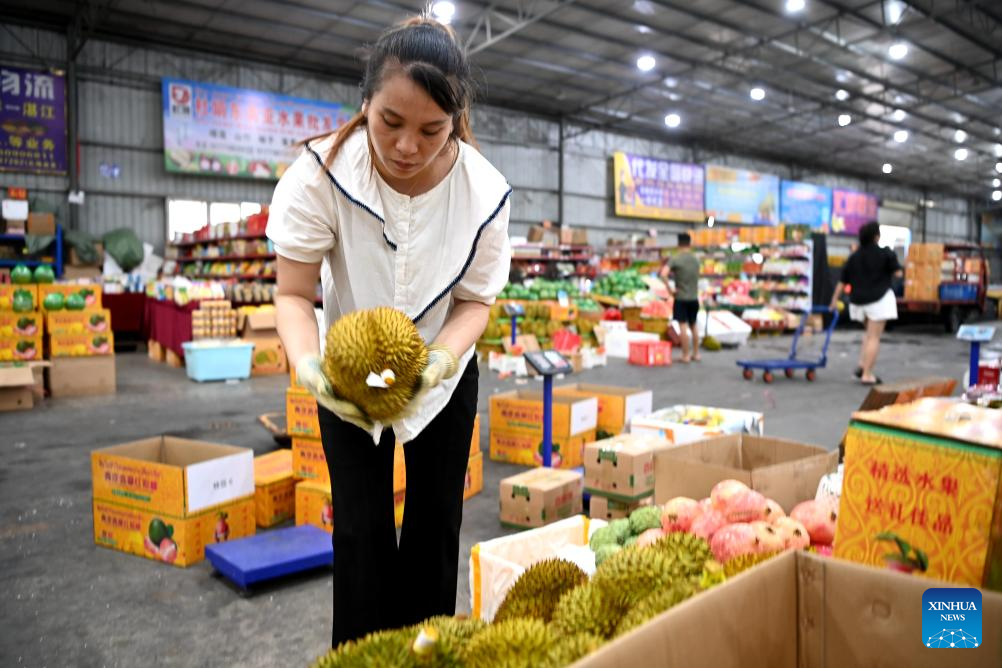
A staff member picks durians for mail order at a market in Pingxiang, south China's Guangxi Zhuang Autonomous Region, on Sept. 12, 2023. As the vast majority of durians sold in the Chinese market are imported from Southeast Asia, the "king of fruits" has emerged as a prominent symbol of the booming China-ASEAN cooperation and China's vast market potential.
The flow of goods in this regional market has continued to benefit from tariff-free policies and expanded market access under the frameworks of the China-ASEAN Free Trade Area and the Regional Comprehensive Economic Partnership (RCEP).
In the first five months of this year, Guangxi imported 3.66 billion yuan worth of fruits from ASEAN countries, a marked rise of 194 percent year on year. Among the most notable increases is durian, which surged 516 percent from the same period last year, according to customs data. (Xinhua/Cao Yiming)



